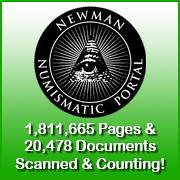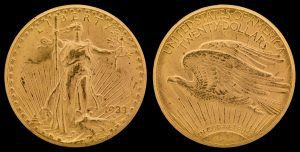
About UsThe Numismatic Bibliomania Society is a non-profit organization devoted to the study and enjoyment of numismatic literature. For more information please see our web site at coinbooks.org SubscriptionsThose wishing to become new E-Sylum subscribers (or wishing to Unsubscribe) can go to the following web page link MembershipThere is a membership application available on the web site Membership Application To join, print the application and return it with your check to the address printed on the application. Print/Digital membership is $40 to addresses in the U.S., and $60 elsewhere. A digital-only membership is available for $25. For those without web access, write to: Terry White, Treasurer AsylumFor Asylum mailing address changes and other membership questions, contact Terry at this email address: terrywhite5475@yahoo.com SubmissionsTo submit items for publication in The E-Sylum, write to the Editor at this address: whomren@gmail.com BUY THE BOOK BEFORE THE COINSale Calendar
|
- WAYNE'S WORDS: THE E-SYLUM APRIL 22, 2018
- KOLBE & FANNING SALE 149 FINAL REMINDER
- NEW BOOK: FRANKLIN AND KENNEDY HALF DOLLARS, 3RD ED.
- NEW BOOK: THE BANKNOTE BOOK: PHILIPPINES
- EBOOKS: DUMBARTON OAKS COLLECTION
- VIDEO: POLYMER BANK NOTES OF THE WORLD
- BERNARD ALAN EDISON (1928-2018)
- STUART DEVLIN (1931-2018)
- OPERATION BERNHARD WORKER HANS WALTER
- DON EVERHART AT THE U.S. MINT
- NEWMAN PORTAL ADDS CHICAGO COIN CLUB CHATTER
- NEWMAN PORTAL SEARCH: TRISTRAM COFFIN
- 1854-S HALF EAGLE DISCOVERY
- 1854-S QUARTER EAGLE OFFERED
- CIVIL WAR SAN FRANCISCO MINT GOLD
- THE WILKISON GOLD PATTERN COLLECTION
- NOTES FROM E-SYLUM READERS: APRIL 22, 2018
- WEB SITE SHOWCASES SPACE-RELATED NUMISMATICA
- FAKE CANADIAN “DEVIL’S FACE” BACKSTORY
- CIVIL WAR TOKEN MAKER RESEARCH HELP SOUGHT
- MORE ON MEGA RED 4TH EDITION U.S. DIME COVERAGE
- NUMISMATIC POETS SOCIETY AWARD
- VOCABULARY TERMS: ADJUSTING, ADJUSTMENT
- VIDEO: ROBOTS AT THE SAN FRANCISCO MINT
- NéSTOR PONCE DE LEóN Y LA GUARDIA (1837-1899)
- ROSE M. TETTENHORST (1936-1989)
- HARVEY STACK'S NUMISMATIC FAMILY, PART 16
- ANA SEEKS PHILADELPHIA MONEY TALKS SPEAKERS
- PEABODY MUSEUM EXHIBITS CALIFORNIA GOLD
- SS CENTRAL AMERICA GOLD NUGGET MEDALS
- MINT TO EXHIBIT 1933 GOLD DOUBLE EAGLE AT PAN
- CANADIAN-AUSTRALIAN MINT LAWSUITS ESCALATE
- WHAT HAPPENED TO THE HARRIET TUBMAN PLAN?
- DLUGOSZ SPRING 2018 PRICE LIST SELECTIONS
- NUMISMATIC NUGGETS: APRIL 22, 2018
- CNG AUCTION 108 CLOSES MAY 16, 2018
- 'HARALD BLUETOOTH' MEDIEVAL TREASURE FOUND
- TRINIDAD AND TOBAGO DISCONTINUES CENT
- 2019 JODY CLARK QUEEN ELIZABETH II EFFIGY
- GERMANS LINE UP TO BUY SPECIAL EURO COIN
- BOER WAR HERO'S ALBERT MEDAL UP FOR SALE
- KARL MARX €0 BILLS ARE RED HOT
- COUNTERFEIT AUSTRALIA $50 BANKNOTES
- INDIANS HOARD CASH AS BANKS RUN OUT
- BASIS: NEW CRYPTOCURRENCY FROM PRINCETON
- THE MAGNET AND BLENDER COUNTERFEIT TESTS
- IN OTHER NEWS: APRIL 22, 2018
- FEATURED WEB SITE: NUMISMACLUB
Click here to access the complete archive
To comment or submit articles, reply to whomren@gmail.com
Content presented in The E-Sylum is not necessarily researched or independently fact-checked, and views expressed do not necessarily represent those of the Numismatic Bibliomania Society.
WAYNE'S WORDS: THE E-SYLUM APRIL 22, 2018
 We now have 5,805 subscribers. Welcome to our newest advertiser, Mark Ferguson's CAC Market Values.
We now have 5,805 subscribers. Welcome to our newest advertiser, Mark Ferguson's CAC Market Values.
Thank you for reading The E-Sylum. If you enjoy it, please send me the email addresses of friends you think may enjoy it as well and I'll send them a subscription. Contact me at whomren@gmail.com anytime regarding your subscription, or questions, comments or suggestions about our content.
This week we open with a final reminder for the upcoming Kolbe & Fanning numismatic literature sale, two new books, some free new e-books, a video look at a polymer banknote book, and three obituaries.
Other topics this week include the Nazi WWII counterfeiting unit Operation Bernhard, the Chicago Coin Club, a new effigy of Queen Elizabeth II, and gold, gold, gold: 1854-S half and quarter eagles, Civil War San Francisco mint gold, the Wilkison gold patterns and some interesting gold nuggets.
To learn more about banknotes of the Philippines, the 1954 "Devil's Face" Canadian banknotes, Byzantine coinage, coin designers Stuart Devlin and Don Everhart, the 1860 $5 Gold Pattern, Civil War token makers, the Numismatic Poets Society, U.S. Mint robots, the Canadian-Australian mint lawsuits, the Glorious First of June, the Chief Wah-She-Hah medal, and the numismatic connection to your Bluetooth connection, read on. Have a great week, everyone!
Wayne Homren
Editor, The E-Sylum
KOLBE & FANNING SALE 149 FINAL REMINDER
FINAL REMINDER & INSTRUCTIONS FOR KOLBE & FANNING’S APRIL 28 BOOK AUCTION
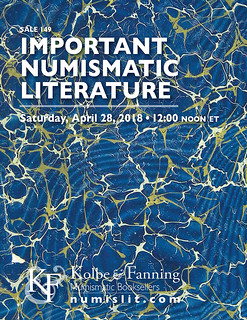 Kolbe & Fanning Numismatic Booksellers will hold Sale 149 this Saturday, April 28, 2017, beginning at 12:00 noon eastern time. Featuring material from the library of William A. Burd and others properties, the
500-lot sale covers ancient, foreign and U.S. numismatics.
Kolbe & Fanning Numismatic Booksellers will hold Sale 149 this Saturday, April 28, 2017, beginning at 12:00 noon eastern time. Featuring material from the library of William A. Burd and others properties, the
500-lot sale covers ancient, foreign and U.S. numismatics.
Bids may be placed via post, email, fax or phone, as well as online. Bids placed via post, email, fax or phone must be received by Friday, April 27, the day before the sale, in order for them to be processed. Kolbe & Fanning uses Auction Mobility as our third-party online bidding platform. Auction Mobility is an app-based platform allowing users the ability to participate in the sale through phones, tablets and computers. To register for the sale, bidders must go to bid.numislit.com and sign up. Once you have set up an account, you may browse lots, place advance bids, or participate in the live sale online. Those wishing to participate on their devices can download the Kolbe & Fanning app through the Apple or Google Play Store.
Advance absentee bids may also be placed online at bid.numislit.com; live internet bidding will be available during the sale itself through the same platform. Bidders placing absentee bids will be able to tell immediately whether or not they have the current high bid. Bidders will also receive email notifications when they are outbid before the sale (users of the app may receive push notifications as well).
Kolbe & Fanning Numismatic Booksellers LLC is a licensed and bonded auction firm in the State of Ohio. For more information, please see the Kolbe & Fanning website at numislit.com or email David Fanning at df@numislit.com. To register for the sale, go to bid.numislit.com. We look forward to your participation.
To read the earlier E-Sylum articles, see:
KOLBE & FANNING SALE 149 CLOSES APRIL 28, 2018 (http://www.coinbooks.org/v21/esylum_v21n14a02.html)
MORE KOLBE & FANNING SALE 149 HIGHLIGHTS (http://www.coinbooks.org/v21/esylum_v21n15a02.html)

NEW BOOK: FRANKLIN AND KENNEDY HALF DOLLARS, 3RD ED.
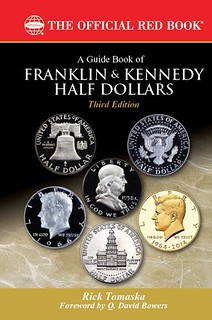 Whitman Publishing announces the release of the updated and expanded new third edition of A Guide Book of Franklin and Kennedy Half Dollars, by professional numismatist Rick Tomaska. The 320-page book will be
available from booksellers and hobby shops nationwide on May 8, 2018, for $19.95. Before then it is available for preorder (including online at www.Whitman.com).
Whitman Publishing announces the release of the updated and expanded new third edition of A Guide Book of Franklin and Kennedy Half Dollars, by professional numismatist Rick Tomaska. The 320-page book will be
available from booksellers and hobby shops nationwide on May 8, 2018, for $19.95. Before then it is available for preorder (including online at www.Whitman.com).
Franklin (1948–1963) and Kennedy (1964 to date) half dollars are two of the most popular series in modern U.S. coinage. “Collectors can enjoy challenges and rewards with these coins whether their hobby budget is $50 a month or $50,000,” said author Tomaska, who provides pricing in multiple grades for each coin. In addition to sharing behind-the-scenes knowledge of the retail and auction markets, Tomaska gives the history of their designs, production, and other technical and cultural aspects.
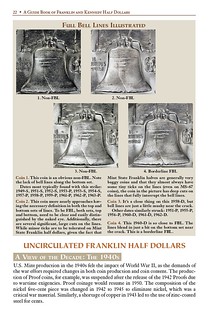
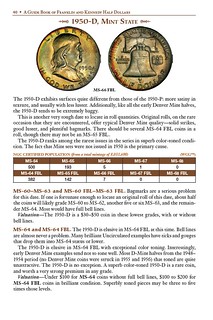
He explores transitions in Mint craftsmanship and reveals why Franklin and Kennedy half dollars represent the end of an era. He studies the coins date by date with commentary on exceptional and highly toned specimens, describes how Proof coins are made and graded, and teaches about Cameo and Deep Cameo contrast, Full Bell Lines, certified coin populations, and other factors important to value and rarity. Collectible die varieties, tips for smart buying, and hundreds of full-color photographs round out the contents.
The third edition has been expanded by more than 10 percent, to 320 pages, with no change in its retail price of $19.95. New features in this edition include record auction and retail prices; coverage of the 1964–2014 gold and silver Kennedy half dollars; and new illustrated appendices on “Exceptional Cameo Contrast” and remarkable error and misstruck Franklin and Kennedy halves. In addition, Tomaska has included an illustrated chapter on Proof Liberty Walking half dollars, which he describes as “true classics born during the wonderful Renaissance era in American coin design” and as precursors to the Proofs of the Franklin series.

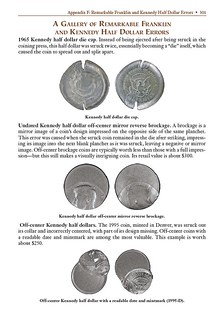
“Longtime specialists will appreciate the new information in this volume,” said Whitman publisher Dennis Tucker, “while beginning collectors will benefit from an immersion in its two very popular and historically significant coin series.”
Numismatic historian Q. David Bowers, writing in the foreword, said, “By reading this book you can become an expert on these widely collected coins.”
A Guide Book of Franklin and Kennedy Half Dollars, 3rd edition
By Rick Tomaska; foreword by Q. David Bowers
ISBN 0794845290
Softcover, 6 x 9 inches, full color
320 pages
Retail $19.95 U.S.
For more information, or to order, see:
(https://www.whitman.com/store/Inventory/Detail/A-Guide-Book-of-Franklin-and-Kennedy-Half-Dollars-3rd-Edition+0794845290)
NEW BOOK: THE BANKNOTE BOOK: PHILIPPINES
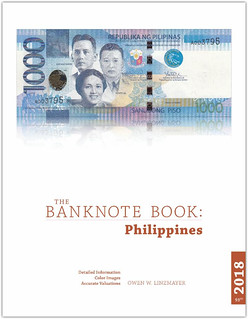 I'm pleased to announce the Philippines chapter is now available for individual sale at US$9.99, and as a free download to subscribers.
I'm pleased to announce the Philippines chapter is now available for individual sale at US$9.99, and as a free download to subscribers.
This is another huge chapter, weighing in at a whopping 87 pages, just behind Germany (91 pages), and China (96 pages), which took the lead with this week's addition of coverage of the Agricultural and Industrial Bank of China.
The Philippines chapter should have a lot of cross-over appeal as it covers notes issued under the Spanish more than 170 years ago, as well as during the US administration in the 20th century, with notes oddly similar to United States issues. Also covered are the World War II issues, and the bewildering array of modern circulating notes and commemoratives.
Philippines (East and Southeast Asia)
This 87-page catalog covers notes issued by El Banco Español Filipino de Isabel II from 1852 to 1865, Tesoro in 1877, El Banco Español Filipino from 1883 to 1908, República Filipina from 1898 to 1899, Philippine Islands
Treasury from 1903 to 1944, Bank of the Philippine Islands from 1912 to 1933, Philippine National Bank from 1917 to 1937, Japanese Government from 1942 to 1945, Central Bank of the Philippines in 1949, and Bangko Sentral ng
Pilipinas from 1969 to present. Published 20.04.2018.
For more information, or to order, see:
http://www.banknotenews.com/
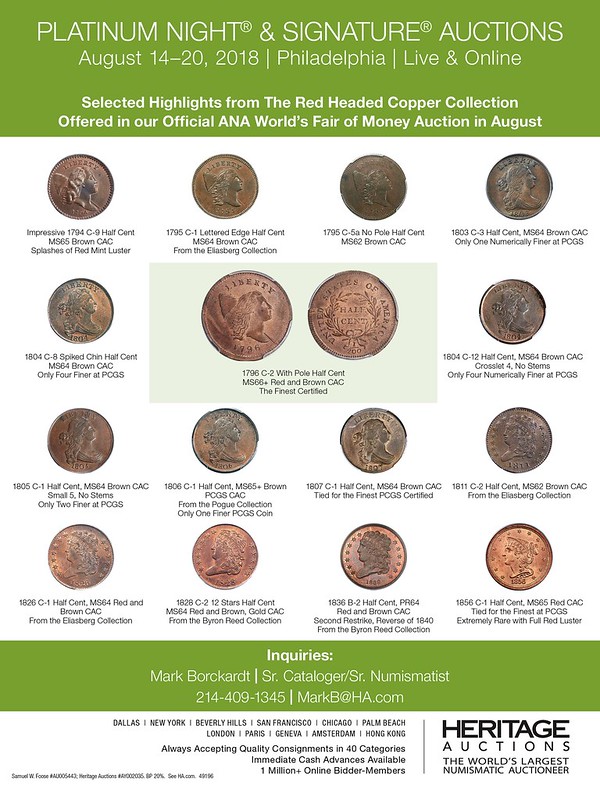
EBOOKS: DUMBARTON OAKS COLLECTION
Ed Hohertz of Cleveland, OH writes:
I just learned from the Numisma site that the five volumes cataloging the Dumbarton Oaks collection are available from their site for free download.
 The 12,000 coins in the Dumbarton Oaks Collection and the Whittemore Collection at the Fogg Art Museum form one of the greatest specialized collections of Byzantine coins in the world. The catalogue, edited by
Alfred R. Bellinger and Philip Grierson, publishes the majority of these coins, dating between 491 and 1453, in five volumes.
The 12,000 coins in the Dumbarton Oaks Collection and the Whittemore Collection at the Fogg Art Museum form one of the greatest specialized collections of Byzantine coins in the world. The catalogue, edited by
Alfred R. Bellinger and Philip Grierson, publishes the majority of these coins, dating between 491 and 1453, in five volumes.
Volume 1 Anastasius I to Maurice, 491–602
(https://www.doaks.org/research/publications/books/
catalogue-of-the-byzantine-coins-in-the-dumbarton-oaks
-collection-and-in-the-whittemore-collection-1)
Volume 2 Phocas to Theodosius III, 602–717
(https://www.doaks.org/research/publications/books/
catalogue-of-the-byzantine-coins-in-the-dumbarton-oaks
-collection-and-in-the-whittemore-collection-2)
Volume 3 Leo III to Nicephorus III, 717–1081
(https://www.doaks.org/research/publications/books/
catalogue-of-the-byzantine-coins-in-the-dumbarton-oaks
-collection-and-in-the-whittemore-collection-3)
Volume 4 Alexius I to Michael VIII, 1081–1261
(https://www.doaks.org/research/publications/books/
catalogue-of-the-byzantine-coins-in-the-dumbarton-oaks
-collection-and-in-the-whittemore-collection-4)
Volume 5 Michael VIII to Constantine XI, 1258–1453
(https://www.doaks.org/research/publications/books/
catalogue-of-the-byzantine-coins-in-the-dumbarton)
Ed adds:
Also a 1982 general work on Byzantine Coinage by Philip Grierson is also downloadable:
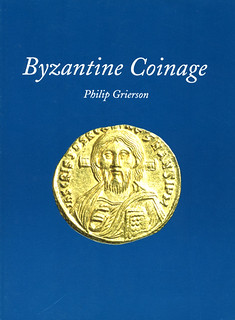 This introductory booklet on Byzantine coinage, first published in 1982, has been updated and expanded to include a description of the creation of the coin collection at Dumbarton Oaks. This new edition marks the
completion of the five volume series Catalogue of the Byzantine Coins in the Dumbarton Oaks Collection.The booklet covers phases of the coinage, gold, silver, and copper coinage, types and inscriptions, and ruler
representations. Tables of values corresponding with various times in the empire’s history, a list of Byzantine emperors, and a glossary are also provided.
This introductory booklet on Byzantine coinage, first published in 1982, has been updated and expanded to include a description of the creation of the coin collection at Dumbarton Oaks. This new edition marks the
completion of the five volume series Catalogue of the Byzantine Coins in the Dumbarton Oaks Collection.The booklet covers phases of the coinage, gold, silver, and copper coinage, types and inscriptions, and ruler
representations. Tables of values corresponding with various times in the empire’s history, a list of Byzantine emperors, and a glossary are also provided.
To read the complete book, see:
https://www.doaks.org/research/publications/
books/byzantine-coinage
To read the Numista post, see:
Byzantine Empire which folis ? (https://en.numista.com/forum/topic69108.html#p560491)
VIDEO: POLYMER BANK NOTES OF THE WORLD

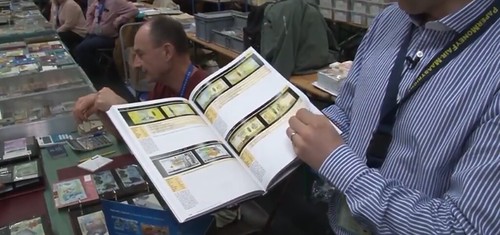
Stane Štraus Managing Director, PBN Ltd, David Lisot, Video Producer, CoinTelevison.com
Since the 1980’s many countries of the world have begun making their banknotes out of plastic. This plastic is called polymer and offers collectors an exciting new way to collector. Stane Štraus has authored the definitive book about these notes including the countries of issue, their images, pricing and more.
To read the complete article, see:
CoinTelevision: "Polymer Bank Notes of the World" Book for Collectors. VIDEO: 2:09. (https://www.youtube.com/watch?v=aNMilC4bRbE)
To read the earlier E-Sylum article, see:
NEW BOOK: POLYMER BANKNOTES OF THE WORLD (http://www.coinbooks.org/esylum_v19n35a03.html)
THE BOOK BAZARRE
BERNARD ALAN EDISON (1928-2018)
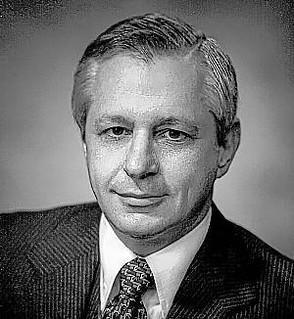 Edison, Bernard Alan aged 90 and former president and CEO of Edison Brothers Stores, Inc, died early Wednesday morning at home, surrounded by family. Mr. Edison - Bunny to his friends built a thriving shoe business
into what was, during the 1970s, the largest women's shoe retailer in the US. He helped diversify the business into a specialty retailer, with stores such as Jeans West, J. Riggings, and 5-7-9.
Edison, Bernard Alan aged 90 and former president and CEO of Edison Brothers Stores, Inc, died early Wednesday morning at home, surrounded by family. Mr. Edison - Bunny to his friends built a thriving shoe business
into what was, during the 1970s, the largest women's shoe retailer in the US. He helped diversify the business into a specialty retailer, with stores such as Jeans West, J. Riggings, and 5-7-9.
In addition to his own accomplishments, Bunny served as a director on the boards of Mercantile Bancorporation, General American Life Insurance Company, Reinsurance Group of America, and Anheuser-Busch Companies, Inc.
As a coin collector, Bunny amassed the world largest collection of half-cents, as well as the world's largest collection of error half-cents - coins that were faulty. He named that collection the Davy Collection, after his youngest son.
Bunny was a talented poet and wordsmith, and would often read poetry to his family. He had a special fondness for Robert Frost and the short stories of O. Henry. He loved keeping up with developments in science and mathematics, a lifelong love of learning that he passed to his children, who loved him very dearly.
To read the complete article, see:
Bernard Alan Edison (https://www.legacy.com/obituaries/stltoday/obituary.aspx?page=lifestory&pid=188793055)
STUART DEVLIN (1931-2018)
We are saddened to hear of the peaceful passing of the beloved designer Stuart Devlin whose designs adorn coins of many countries including many of those you have in your pocket or wallet right now. He's the designer of the platypus 20 cent, the iconic mob of roos dollar, the teeny echidna 5 cent, in fact he designed all of Australia's standard decimal coin reverses that have been in circulation since 1966 (except the $2 coin issued later).
Not only has Mr Devlin designed coins but also silver art pieces, gold jewellery, sculptures, furniture and he's even designed houses. A book "Stuart Devlin Designer, Goldsmith, silversmith" written by his wife Carole Devlin and her sister Victoria Kate Simkin was recently published detailing his lifes work and includes a biography which is a tribute to his achievements in life.
Stuart Devlin AO born in 1931 was 86 and passed away April 12th 2018.
To read the complete article, see:
Vale Stuart Devlin Your Iconic Coin Designs Forever in My Pocket
(https://www.australian-coins.com/coin-news/vale-stuart-devlin-iconic-coin-designs-forever-pocket/)
 Stuart Leslie Devlin, AO, CMG was born on 9 October 1931 and died on 12 April 2018. He was an Australian artist and metalworker who specialises in gold and silver. He designed coins for countries around the world,
and became especially well known as London-based designer of collector's items in the 1970s and 1980s.
Stuart Leslie Devlin, AO, CMG was born on 9 October 1931 and died on 12 April 2018. He was an Australian artist and metalworker who specialises in gold and silver. He designed coins for countries around the world,
and became especially well known as London-based designer of collector's items in the 1970s and 1980s.
Devlin was born in Geelong, Victoria, Australia, and became an art teacher, specializing in gold and silversmithing. In 1957, he obtained a post at the Royal Melbourne Institute of Technology and studied for a Diploma of Art in gold and silversmithing. He was awarded scholarships to study at the Royal College of Art in London in 1958, and was awarded a Harkness Fellowship by the Commonwealth Fund. He spent the two-year fellowship at Columbia University, United States.
He returned to teach in Melbourne in 1962 and subsequently became an inspector of art schools. He rose to fame when, in 1964, he won a competition to design the first decimal coinage for Australia. In 1965, he moved to London and opened a small workshop. This marked the beginning of Devlin's own style, which often took the form of limited editions, the most popular being Easter eggs and Christmas boxes, now collectors' items.
Among his most popular commissions, Devlin has designed coins and medals for 36 countries throughout the world, including precious coins for the Sydney 2000 Olympic Games and the medals for the founding awards of the Australian honours system in 1975: the Order of Australia, the Australian Bravery Decorations and the National Medal. In 1982, Devlin was granted the Royal Warrant of Appointment as Goldsmith and Jeweller to Her Majesty the Queen.
To listen to the complete video, see:
Australian goldsmith Stuart Devlin Died at 86 (https://www.youtube.com/watch?v=G1tjqDDVKNI)
To read the complete Wikipedia article, see:
Stuart Devlin (https://en.wikipedia.org/wiki/Stuart_Devlin)
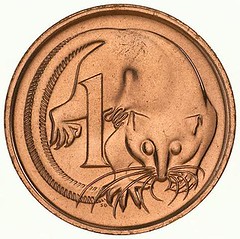

Australia 1 and 2 cents
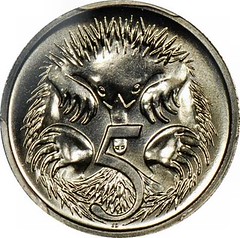

Australia 5 and 10 cents

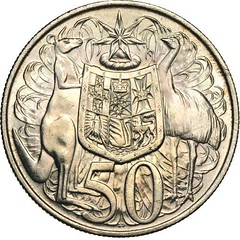
Australia 20 and 50 cents
To read the complete article, see:
Stuart Devlin, Coin Designer (http://www.worldofcoins.eu/forum/index.php?topic=8796.0)
To read earlier E-Sylum articles, see:
NEW BOOK: THE HISTORY AND ART OF AUSTRALIAN COINAGE (http://www.coinbooks.org/esylum_v19n08a05.html)
NEW BOOK: STUART DEVLIN (http://www.coinbooks.org/v21/esylum_v21n11a03.html)

OPERATION BERNHARD WORKER HANS WALTER

Operation Bernhard survivor and Fester Hans Walter died on April 20th. Han who has attended MPCFest on several occasions slipped away on Friday with his family nearby. His passing was reported by Danny Spungen. Spungen and Walter are shown above at MPCFest.
Danny called me that he was on the road heading for Ohio. Danny said that had found a survivor of Operation Bernhard. He lived in Mansfield, Ohio. Danny was going to visit him, did I want to go along? Oh my, what a request. I was thrilled to have the opportunity. Danny picked me up and we were on our way.
We arrived in Mansfield (just the two of us) in good order, bursting with enthusiasm and questions. We were greeted by Hans Walter, who was indeed a survivor of Auschwitz, transferred to the Sachsenhausen concentration camp as a member of Operation Bernhard.
... Hans became a final inspector of notes. Likely he had other jobs along the way, but it was the inspector job that he described the most to us. Hans was very proud to say that he was in charge of the final inspection stages (of which there were about five).
After the war Hans came to the United States, where he married, raised a daughter, and worked at the General Motors factory in Mansfield.
We showed Hans a few Bernhard notes that Danny had taken along. Hans confirmed that they were indeed Bernhard notes, although I do not know how he identified them. Danny was quick to tell Hans, that “we collectors can pretty easily distinguish a genuine from a counterfeit note.” Hans was disturbed by this “accusation,” because he said he would not be living today if it was easy to detect the differences. In fact, he started to shake his little four-legged card table, saying it was not easy. After a discussion, we back-tracked and told him that “today,” given all the information we have, it is easy, but of course back in 1944 it was not easy at all, and that is why the operation was so successful!
Hans indicated that these were the first examples that he had seen since the war.
To read the complete article, see:
OPERATION BERNHARD SURVIVOR HANS WALTER (http://www.coinbooks.org/esylum_v18n31a33.html)
DON EVERHART AT THE U.S. MINT
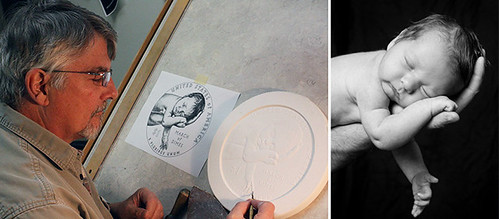
I began in my new position by cleaning dies, changing dates on pennies and nickels, and started working up some designs. John, who was in charge of handing out sculpting assignments, gave me the California State Quarter to sculpt! I couldn’t believe that I was actually sculpting a coin to be circulated in the very successful 50 State Quarters program.
John also gave me the reverse of his Jackie Robinson Congressional Gold Medal design to sculpt. I still appreciate the guidance John gave me while he was the Chief Engraver of the United States Mint.
I worked for about a year developing designs, none of which were chosen. I thought were good enough, but, for whatever reason, they weren’t making much of an impression on the CFA (Committee For Fine Arts) or the CCAC (Citizens Coinage Advisory Committee) in Washington, DC.
One day I conveyed my dismay to Dave Puglia, who was Acting Plant Manager at the time. He told me, “Don’t worry, you are going to get designs chosen, and they will come in bunches.”
To read the complete article, see:
Don Everhart: My Career in Coins, Part 2 – The United States Mint
(https://coinweek.com/editors-choice/don-everhart-career-in-coins-part-2-the-united-states-mint/)

NEWMAN PORTAL ADDS CHICAGO COIN CLUB CHATTER
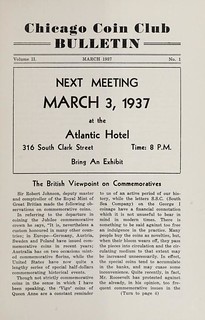 One of the longest running club publications in American numismatics, the Chicago Coin Club (CCC) Chatter, has been digitized and added to the Newman Numismatic Portal. The Chicago Coin Club was the first
member club of the ANA, designated “branch number 1” in 1912. The CCC Chatter contains many feature articles in addition to the usual club news and notices. The March 1940 issue, for example, includes “Chinese Women
in Numismatics” in addition to “The Twenty Cent Piece of the United States.” Current issues feature well-written summaries of presentations made at the monthly club meetings, covering a wide cross-section of numismatic
interest.
One of the longest running club publications in American numismatics, the Chicago Coin Club (CCC) Chatter, has been digitized and added to the Newman Numismatic Portal. The Chicago Coin Club was the first
member club of the ANA, designated “branch number 1” in 1912. The CCC Chatter contains many feature articles in addition to the usual club news and notices. The March 1940 issue, for example, includes “Chinese Women
in Numismatics” in addition to “The Twenty Cent Piece of the United States.” Current issues feature well-written summaries of presentations made at the monthly club meetings, covering a wide cross-section of numismatic
interest.
The earliest issues exhibit a professional look and feel similar to Lee Hewitt’s Numismatic Scrapbook and may well have been produced by Hewitt Bros., a Chicago publishing concern. The Chatter today is capably edited by Paul Hybert, who also acts as club webmaster. Newman Portal acknowledges Bill Burd of the Chicago Coin Club for his assistance with this project.
Link to Chicago Coin Club Chatter on Newman Portal:
https://nnp.wustl.edu/library/publisherdetail/525556
NEWMAN PORTAL SEARCH: TRISTRAM COFFIN
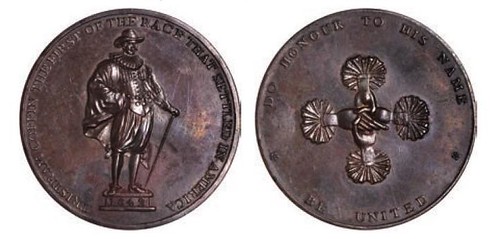
This week a Newman Portal user searched for “Tristram Coffin.” Was this a trade token for a 19th century undertaker? No, and that would be a bad guess. An appearance in the Stack’s Bowers March, 2016 Baltimore sale identifies the Tristram Coffin medal as Betts-533, and from there Betts’ American Colonial History Illustrated by Contemporary Medals gives further information, as supplied by editors Lyman H. Low and William T. R. Marvin:
“This Medal was undoubtedly struck under the direction of Admiral Sir Isaac Coffin of the British Navy, who was born in Boston, Mass., in 1750. While it bears the name and an imaginary likeness of one of the early settlers of the Island of Nantucket, we believe the date of its issue was much later than that ascribed to it in Med. Ill. [Medallic Illustrations of the History of Great Britain…., 1885], and that it was struck about the beginning of the present [19th] century. If we are correct, it cannot fairly be placed in this list; but Mr. Betts included it, following the authority cited, and we therefore allow it to remain. Sir Isaac is said to have presented impressions to all male descendants of Tristram bearing his name.”
The Stack’s Bowers cataloger notes these medals were actually produced in 1827 by Thomas Halliday in England, making this one of the “youngest” pieces documented in Betts 1894 reference.
Image: Tristram Coffin medal from Stack’s Bowers March, 2016 Baltimore sale, lot 12006, realized $493.50.
Link to Stack’s Bowers March, 2016 Baltimore sale:
https://nnp.wustl.edu/library/auctionlots?AucCoId=3&AuctionId=517117&page=18
Link to C. Wyllys Betts’ American Colonial History Illustrated by Contemporary Medals on Newman Portal:
https://nnp.wustl.edu/library/book/519282
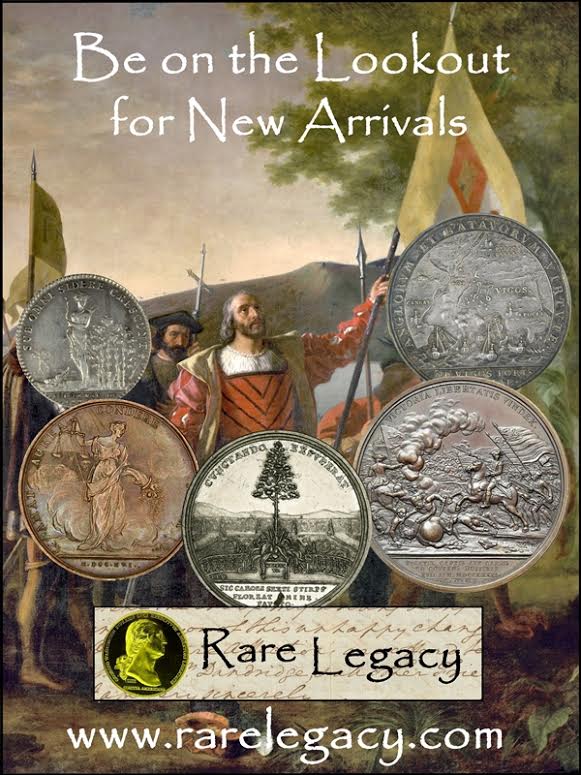
1854-S HALF EAGLE DISCOVERY

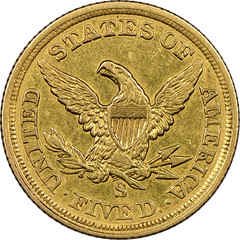
A New England coin owner has hit the jackpot after a coin he purchased as a fake turned out to be a 164-year-old gold piece minted during the California Gold Rush.
The $5 coin, called a “Half Eagle,” is one of four known surviving examples minted in San Francisco in 1854, the first year coins were made there, according to the Numismatic Guaranty Corp. of Sarasota.
The Smithsonian Institution in Washington, D.C., and a Texas family own other examples. A third owned by industrialist Willis DuPont has not been seen since it was stolen in 1967.
The rare coin inspected by NGC is not the long-lost DuPoint coin, according to NGC President Rick Montgomery, who said markings shown on that coin in photographs ruled it out.
The newly discovered coin was graded to be an “extremely fine 45,” on the Sheldon Grading Scale — a 70-point condition score for coins. It is estimated to be worth millions.
The New Englander’s Half Eagle was “slightly worn” but close to its original weight. A friend of the man brought the coin to be inspected along with other coins. Other collectors and dealers had ruled that it was fake.
They were mistaken.
“I think when they first purchased it they felt like anyone else — it’s too rare to be a real coin,” Montgomery said. “When they were told, ‘You have the real coin,’ they were quite shocked.”
As to why other coin experts rejected the coin, Montgomery says it’s existence is “unbelievable.”
“I think they went with the presumption anything this rare I’m not going to encounter,” Montgomery said. “They didn’t give it that detail to attention they should have.”
One of NGC’s chairman likened the discovery to finding a “Picasso at a garage sale,” Montgomery said.
Jeff Garrett of Lexington, Kentucky, a rare coin consultant to the Smithsonian and a former president of the American Numismatic Association, described the coin’s existence as “a stunning discovery” after Montgomery showed him images of it.
But owning one of the rarest coins on earth is costly. Taxes could force the owner to sell it at auction or privately.
“It’s completely up there with the 1933 $20 gold piece,” said Montgomery of the $7.5 million coin embroiled in a court battle in 2011. “There’s only one in private hands. I had the great fortune to see that coin 15 years ago or so. The 1854 Half Eagle is up there with a lot of other great rarities; it ranks with all the great rarities in the U.S. coinage.”
Doug writes:
Can't add much to this other than my initial reaction which rhymed with Roly Wit... Amazing discovery!!
To read the complete article, see:
Sarasota firm says collector’s fake coin is actually real and worth millions
(http://www.heraldtribune.com/news/20180418/sarasota-firm-says-collectors-fake-coin-is-actually-real-and-worth-millions)
To read the earlier E-Sylum articles, see:
ARTICLE REPORTS 1894-S DIME DISCOVERY (http://www.coinbooks.org/v20/esylum_v20n38a15.html)
ARTICLE ON 1894-S DIME DISCOVERY WITHDRAWN (http://www.coinbooks.org/v20/esylum_v20n39a09.html)
1854-S QUARTER EAGLE OFFERED
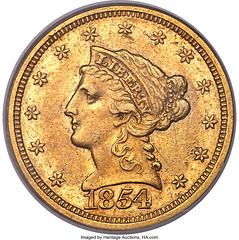
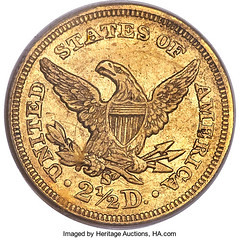
1854-S $2 1/2 VF35 PCGS Secure. Ex: Davis-Graves, Norweb. The present offering of a VF35 PCGS 1854-S quarter eagle ranks among the most memorable lots in this sale; in fact, the 1854-S quarter eagle is among the most memorable U.S. coin issues of all time, regardless of the particular venue. Only 246 examples were produced in the first year of operations at the San Francisco Mint, and it appears that all of them quietly slipped into circulation. Legendary Fort Worth, Texas, coin dealer B. Max Mehl discovered the first reported specimen in 1910 through his "extensive advertising," a piece he apparently sold privately to prominent Wisconsin collector H.O. Granberg.
In addition to Granberg, the list of former owners of 1854-S quarter eagles today is a Who's Who of American numismatic luminaries of several generations: Atwater, Clapp, Wolfson, Boyd, Norweb, Eliasberg, Bass. The acquisition of this Choice VF specimen will confer instant numismatic immortality on its possessor.
Interestingly, Mint Marks author Augustus Heaton was apparently quite confused on the rarity of some of the early mintmarked gold issues. He seems to have been aware of the production of the 1854-S quarter eagle and half eagle (mintage 268 coins, of which but three are known today), but he calls only the five dollar issue "exceedingly rare." His pamphlet, published in 1893, says of S-mint quarter eagles:
"The San Francisco issue is from 1854 to '79, except '55, '64 and '74. The great prize of the series is 1858. 1876 is scarce, but no other date should be so from the amount coined."
Today we know that San Francisco made no quarter eagles in 1858 -- and we wonder what mintage figure he was using for the 1854-S.
As our detailed roster below indicates, somewhere between a dozen and a dozen and a half examples -- no more -- can be traced today. No Uncirculated examples of the 1854-S quarter eagle are known, and any survivor is sure to cause fervent bidding among the many specialists in Western gold.
The San Francisco Mint opened on April 3, 1854, in a renovated building formerly occupied by Moffat and Co., striking its first gold coin, an 1854-S proof double eagle now in the National Numismatic Collection of the Smithsonian. It is a mystery why San Francisco struck so few quarter eagles and half eagles during the year, as it produced a modicum of Type One gold dollars and a great quantity of double eagles and eagles -- in fact, the new branch mint struck every authorized gold denomination during the year except the three dollar gold. In the case of the quarter eagles, while the circumstances surrounding the low mintage are lost today, it continues a trend that persisted throughout the denomination's history at the Mint, to treat it as the "red-headed stepchild" of U.S. gold coinage. (The half eagle is even more curious, as the five dollar gold was a workhorse denomination with plentiful mintages for most of Mint history; whatever the circumstances were, they clearly were unique to the time, place, and economic situation; perhaps bullion depositors simply preferred the larger eagle and double eagle at the time when available parting acids made gold coinage feasible.)
In the appearance of this coin in the Norweb Collection, the cataloger noted:
"In addition to the low recorded mintage, the 1854-S has the distinction that in David Akers' survey it was the second rarest quarter eagle in terms of the number of auction appearances over the years, and was tied with the exceedingly rare 1806/5 overdate and the 1841. Only the 1814 variety with 13 reverse stars appeared less frequently."
To read the complete lot description, see: 854-S $2 1/2 VF35 PCGS Secure.... (https://coins.ha.com/itm/liberty-quarter-eagles/1854-s-2-1-2-vf35-pcgs-secure/a/1274-4314.s?ctrack=200071)

CIVIL WAR SAN FRANCISCO MINT GOLD
San Francisco Branch Mint Civil War Gold $10, $5, and $2 1/2.
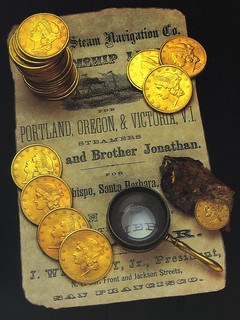 Recently rare gold expert and author Doug Winter had a beautiful PCGS MS 64 1865-S double eagle with a Brother Jonathan pedigree for sale, that brought back a flood of memories. In February of 2013, I wrote
an article for Coin World on the wreck that began with the following passage, “On July 30, 1865, the side wheel steamship S.S. Brother Jonathan was violently impaled on a rock pinnacle off Crescent City, California.
Driven by wind and waves she teetered back and forth before breaking free from the rock. Ripped open by the collision, a wall of water rushed into her hull. Mortally wounded, she was at the mercy of the elements and drifted
away from the scene. Panicked passengers scrambled to her deck. Only one of several lifeboats was successfully launched from her wildly pitching hull, and in less than an hour she plunged to the bottom with a great loss of
life. Her sinking remains California’s greatest maritime tragedy.”
Recently rare gold expert and author Doug Winter had a beautiful PCGS MS 64 1865-S double eagle with a Brother Jonathan pedigree for sale, that brought back a flood of memories. In February of 2013, I wrote
an article for Coin World on the wreck that began with the following passage, “On July 30, 1865, the side wheel steamship S.S. Brother Jonathan was violently impaled on a rock pinnacle off Crescent City, California.
Driven by wind and waves she teetered back and forth before breaking free from the rock. Ripped open by the collision, a wall of water rushed into her hull. Mortally wounded, she was at the mercy of the elements and drifted
away from the scene. Panicked passengers scrambled to her deck. Only one of several lifeboats was successfully launched from her wildly pitching hull, and in less than an hour she plunged to the bottom with a great loss of
life. Her sinking remains California’s greatest maritime tragedy.”
My history with the ship dated back to the 1990's when I was given the opportunity to do research on the wreck for Q. David Bower's The Treasure Ship S.S. Brother Jonathan, Her Life and Loss, 1850-1865, a book that I highly recommend for anyone interested in this shipwreck. In May of 1999, Bower's and Merena conducted the auction sale of the S.S. Brother Jonathan's golden treasure awarded to Deep Sea Research, whose divers recovered the bounty. The majority of the coins made available to the collecting public were Mint State 1865-S double eagles. However, I do remember that an impressive, MS- 64 1865-S over inverted 186, eagle, (still the finest known example) was also recovered and sold. While a rare coin in its own right, the 1865-S normal date eagle is even rarer.
Once lost in the shadows of the 1861-1865- S double eagles, the collector demand for San Francisco Branch Mint Civil War gold eagles, half eagles, and quarter eagles has increased exponentially in the last decade. The rarity of these coins is no longer going unnoticed by rare gold collectors. For the majority of these dates in this 14 piece set, properly graded AU 55-58 pieces are the best that a collector can hope to attain with two notable stoppers. The 1864-S eagle and half eagle are out of the financial reach of most collectors when they become available.


There are currently no known 1864-S eagles in Mint State condition and properly graded AU pieces are prohibitively rare. On July 1st, 2,500 eagles were delivered from the coiner and 3,880 half eagles on the 11th. According to Winter, few 1864-S half eagles exist over EF 45. By some small numismatic miracle there is an Uncirculated 1864-S half eagle that is of stellar quality from the Bass II Sale. Survival rates for both issues is around two dozen each.
The 1862-S is the second rarest San Francisco Branch Mint Civil War half eagle with a mintage of under 10,000 pieces and most surviving examples are found in a well worn state. While 8,000 1861-S half eagles were delivered from the coiner on August 26th and 10,000 on November 13th no Uncirculated pieces are currently known.
The rarest quarter eagle from the group is the 1863-S. Doug Winter estimates that less than 1% of the coin's original mintage survived just barely edging out the 1862-S quarter eagle in terms of rarity.
Collectors interested in San Francisco Branch Mint Civil War eagles, half eagles and quarter eagles, will have to make an effort to find pieces with naturally toned surfaces or coins that have not been processed with an abrasive substance.
Outside of shipwreck recovery pieces, most of these coins were not frozen in time and as a result were abraded while circulating heavily in commercial channels. Still, each coin represents a historic testament to California's continued gold production during this nation's great conflict.
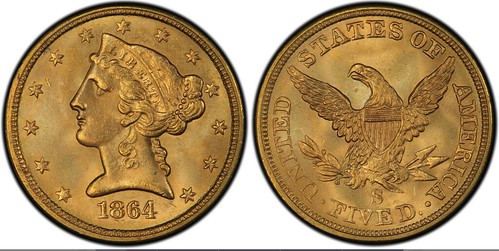
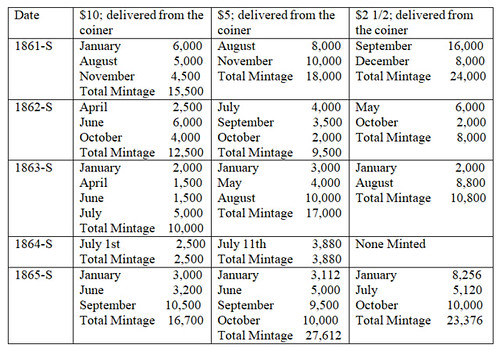
In 1861, there was a shortage of small gold coinage back East. So for over a month, the Philadelphia Mint reportedly devoted three days a week to striking half and quarter eagles, etc., instead of the dominant double eagles. This resulted in larger mintage figures for 1861 Philadelphia Mint eagles, half eagles and quarter eagles, versus their San Francisco Branch Mint counterparts of the same date.
As the Civil War dragged on, less California gold was being shipped from San Francisco by sea to Panama and thence by rail over to Aspinwall and by sea again to New York City and on to the Assay Office. Here it would have been refined and sent to the Philadelphia Mint for coinage. Instead the California bullion was being shipped direct to London from Aspinwall. Thus most notably in 1863, 1864 and 1865, Philadelphia Mint coinage numbers for eagles, half eagles and quarter eagles plummeted to numbers that are generally less than their San Francisco Branch Mint counterparts. The exceptions being the low mintage 1864-S eagles and half eagles.
THE WILKISON GOLD PATTERN COLLECTION
In September 1973, Paramount International Coin Corporation (under the auspices of the noted gold coin expert, David Akers) purchased the collection of Dr. John E. Wilkison of Springfield, Tennessee. The collection consisted of 47 gold U.S. Pattern coins, 35 of which were different, and eight pieces that were unique. Dr. Wilkison built his collection over the period from 1942 to 1973, purchasing coins from the likes of dealers Charlie Green (who represented Dr. Wilkison at the 1954 sale of the King Farouk collection) and Abe Kosoff (who provided several major rarities and helped broker a mega-trade with the pattern specialist and author, Dr. J. Hewitt Judd). Dr. Wilkison’s collecting accomplishments surpassed those of any previous collector of gold U.S. Pattern coins (the King Farouk collection was the only one that was close and it had fewer different pieces and fewer total pieces).
In 1975, Akers published a book titled, “United State Gold Patterns: A Photographic Study of the Gold Patterns Struck at the United States Mint from 1836 to 1907.” Leaning heavily on the Wilkison collection and borrowing images from other collections and institutions, Akers was able to illustrate 46 of the 51 gold pattern coins. For the missing five pieces, Akers used copper versions of the same Judd numbers as illustrations.
In subsequent years, the Wilkison collection was broken up and sold off. Most have ended up in strong hands, which means they will not be entering the market any time soon. This, then, is the first of a series of articles that will seek to track down the coins from the Wilkison collection and update pedigree chains and grades, where known. Have the coins scattered to the winds or is there another collector who is trying to surpass Dr. Wilkison’s accomplishment? Stay tuned.

1860 $5 Gold Pattern, Judd 271, Pollock 319, Gold, Reeded Edge
Judd 271 is unusual in that the diameter is the same as a $10 gold piece, but to keep the weight the same as a regular $5 gold piece, the planchet was rolled out much thinner than normal. Another unusual aspect of Judd 271 is that the V in FIVE is actually an inverted A. Judd 271 is represented by only two examples, both of which (amazingly, but not surprsingly) were once owned by Dr. Wilkison. The good doctor acquired his first example in the early 1940’s from Abe Kosoff for $4,200. In 1962, Dr. Wilkison traded for Dr. Judd’s collection of gold patterns, which included a second (and better) Judd-271. Wilkison retained both examples, presumably keeping the first one as potential trade bait.
To read the complete articles, see:
REVISITING THE DR. JOHN E. WILKISON COLLECTION OF GOLD U.S. PATTERNS
(http://www.pcgsblog.com/ron-guth/news/revisiting-the-dr-john-e-wilkison-collection-of-gold-u-s-patterns)
REVISITING THE DR. JOHN E. WILKISON COLLECTION OF GOLD U.S. PATTERNS, Part II
(http://www.pcgsblog.com/ron-guth/news/revisiting-the-dr-john-e-wilkison-collection-of-gold-u-s-patterns-part-ii)
REVISITING THE DR. JOHN E. WILKISON COLLECTION OF GOLD U.S. PATTERNS, Part III
(http://www.pcgsblog.com/ron-guth/news/revisiting-the-dr-john-e-wilkison-collection-of-gold-u-s-patterns-part-iii)
REVISITING THE DR. JOHN E. WILKISON COLLECTION OF GOLD U.S. PATTERNS, Part IV
(http://www.pcgsblog.com/ron-guth/news/revisiting-the-dr-john-e-wilkison-collection-of-gold-u-s-patterns-part-iv)
REVISITING THE DR. JOHN E. WILKISON COLLECTION OF GOLD U.S. PATTERNS, Part V
(http://www.pcgsblog.com/ron-guth/news/revisiting-the-dr-john-e-wilkison-collection-of-gold-u-s-patterns-part-v)
REVISITING THE DR. JOHN E. WILKISON COLLECTION OF GOLD U.S. PATTERNS, Part VI – 1873 to
1876 (http://www.pcgsblog.com/ron-guth/news/revisiting-the-dr-john-e-wilkison-collection-of-gold-u-s-patterns-part-vi-1873-to-1876)

NOTES FROM E-SYLUM READERS: APRIL 22, 2018
1796 Dime Embedded in a Ladle

Ron Guth of San Diego, CA writes:
The coin in the eBay ladle submitted by Phil Mernick is a 1796 Dime (JR-6). Considering that it show most of the die cracks associated with that variety, it is most likely real.
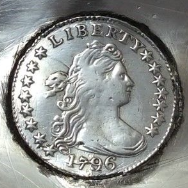
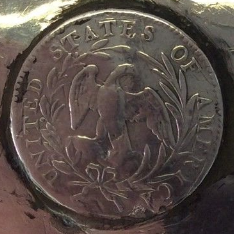
To read the earlier E-Sylum article, see:
1796 COIN LADLE (http://www.coinbooks.org/v21/esylum_v21n15a23.html)
Gold In Commerce in the 1970s
Larry Bennett of Boise, ID writes:
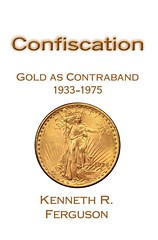 Around 1968, my father became a real estate agent as his fourth or fifth career (his first love of sheep ranching died in the Depression and his main career was a long haul truck driver which was different in the
1940's and 1950's than now). He retired totally around 1973. He was the salesman for a small ranch near Boise, Idaho, around 1970 and the commission was paid in $20 gold coins. I do not remember how many he received
but I recollect it was over 20 coins.
Around 1968, my father became a real estate agent as his fourth or fifth career (his first love of sheep ranching died in the Depression and his main career was a long haul truck driver which was different in the
1940's and 1950's than now). He retired totally around 1973. He was the salesman for a small ranch near Boise, Idaho, around 1970 and the commission was paid in $20 gold coins. I do not remember how many he received
but I recollect it was over 20 coins.
Each of his four children got a coin (I still have mine), his church got at least one, and the rest were sold. The dealer recommended that he sell them periodically to not flood the market so he must have had enough to be of concern. As the price of gold was climbing, it also improved his bottom line. This was shortly after gold was again allowed to be sold but the man who paid the commission must have held the coins for many years.
I will be purchasing the book to see if this was illegal in those days and to learn more about this part of history.
To read the earlier E-Sylum articles, see:
NEW BOOK: CONFISCATION: GOLD AS CONTRABAND (http://www.coinbooks.org/v21/esylum_v21n12a04.html)
BOOK REVIEW: CONFISCATION (http://www.coinbooks.org/v21/esylum_v21n15a05.html)
Father-Son Mint Engravers ANA Seminar Class
John Frost writes:
There is a class at the ANA Summer Seminar that we are teaching: The Legacy and Coinage of Father-Son Mint Engravers William and Charles Barber. It is during Session 2, between June 24-28.
To read the earlier E-Sylum article, see: 2018 ANA SUMMER SEMINAR (http://www.coinbooks.org/v21/esylum_v21n05a22.html)
An Aragon Ballroom Encased Franklin Half
Web site visitor Angela Cloud writes:
I just came across an Aragon Ballroom Encased Franklin Half Dollar with some of my mother’s coins. She lived in Santa Monica from 1935 - 1973. A Google search brought me to your article.
Since you asked anyone who has seen similar encased coins to contact you, I thought I’d send you a picture. It’s the same as one you listed, a 1953 Franklin half dollar in a clear encasement with red writing from Aragon Ballroom.
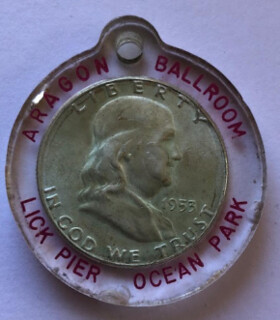
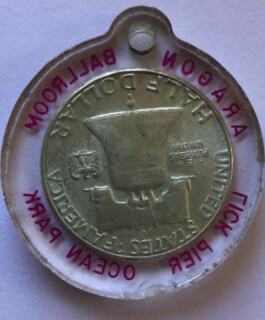
To read the earlier E-Sylum articles, see:
THE ARAGON BALLROOM ENCASED FRANKLIN HALF (http://www.coinbooks.org/esylum_v18n07a16.html)
MORE ON THE ARAGON BALLROOM (http://www.coinbooks.org/esylum_v18n08a15.html)
Beware Translated Names!
Last week Gary Beals wrote:
One of my gripes about historians is the translation of people’s names. I maintain that the name someone was given in his or her native land cannot and should not be translated — doing so only confuses things.
I don't want to go into this in depth or I may never stop - it's a bit of a minefield. I agree that we're steadily moving away from the habit of translating names, but it's a long process and not always easy or even practical - especially with regard to multi-lingual countries. Do we want to refer to the capital of Belgium in triplicate every time (Bruxelles/Brussel/Brüssel) because the country is officially trilingual and we mustn't leave any of its language groups out? Or indeed the country itself (Belgique/België/Belgien)? And could we ever get English speakers to cope with referring to Egypt as Misr, since that's what it is in Arabic?
It's one of those case-by-case things, where historical practice is best adhered to, depending on the period, places and personages involved. It's been standard in English to refer to "Ferdinand and Isabella" for 500 years, and it would create more confusion to go changing it now. Different languages have their own practices in this regard, too - as evidenced by the Spanish-language examples your contributor quotes.
I'm in the language business, and watching what makes other languages tick has been a source of pleasure and mental exercise since I was a child. Dabbling in Hungarian in recent years, I was briefly puzzled by a reference to "Tüzföld", which I first translated into English as "fire-land"; that didn't make much sense, and I had to go a step further and render it into Spanish to get Tierra del Fuego - success! Call me a masochist ("OK, you're a masochist!"), but I really don't want to be denied that pleasure.
Something else to bear in mind is pronunciation - each language creates its own "shape" in the inside of your mouth, and having to stop and re-form to give a foreign name its "authentic" pronunciation in the middle of an English sentence is awkward at best, and bordering on the pompous at worst. It's a requirement with Maori names here in NZ now, and the poor old radio and TV announcers tie themselves in knots trying to get it right, and in most cases still either overdo it or make a mess of it. Do we as numismatists and historians want to have to learn the pronunciation rules of several dozen languages to be able to honour the original forms of every historic or foreign name we encounter?
To read the earlier E-Sylum article, see:
BEWARE TRANSLATED PERSON AND PLACE NAMES (http://www.coinbooks.org/v21/esylum_v21n15a25.html)
Oldest Mintmark in the U.S.?

Today, the San Francisco Mint is the largest producer of #collectible #coins in the U.S. and the largest proof #coin producer in the #world. It also has the #unique distinction of having the oldest mint mark in the U.S. http://ow.ly/sVRy30jxTHt
Ron adds:
The New Orleans, Dahlonega, and Charlotte mintmarks are "older" than San Francisco's. Perhaps they meant the longest surviving mintmark.
To read the original tweet, see:
https://twitter.com/DavidZanca/status/986688436622036992
World Book Night
Dick Johnson writes:
It’s World Book Night April 23rd. What? You never heard of it? Well it’s not celebrated in America like it is in a couple countries in Europe.
There is also World Book Day, which has a couple names, International Day of the Book for one, World Book and Copyright Day for another. It was organized by UNESCO to bring recognition to publishing and copyright and encourage reading.
It was first celebrated in Spain where April 23 was chosen as Cervantes death date, which by coincidence was Shakespeare's date of death as well, but not the same year of course. In England it was moved to the first Thursday in March for a conflict with Easter and is most actively celebrated in schools to promote reading to youngsters often in creative ways.
It’s almost unheard of in America. But book publishing and marketing is not overlooked. Over 65 book fairs are held in yearly in America. Often these are specialized, as antiquarian books, or of a topic. It’s like multiple book stores in one location.
I have frequently found numismatic books at such fairs.
For more information, see:
http://worldbooknight.org/
WEB SITE SHOWCASES SPACE-RELATED NUMISMATICA
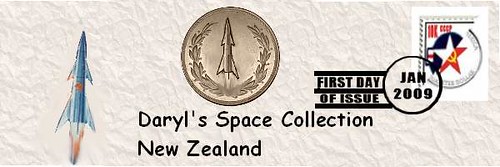
There's a collector in New Zealand who is interested in collecting space coins and medallions. There are assorted other links on his website to his collection of flown (material) medallions and meteorite coins. While these are not the sort of items I collect, the site shows a bunch of different items, so it is a worthwhile resource if you are interested in finding out about a space related coin or medallion you might have seen someplace.
To visit the web site, see:
http://www.spacecollection.info/
To read the CoinTalk item, see:
New site for showing assorted space related coins and medallions
(https://www.cointalk.com/threads/new-site-for-showing-assorted-space-related-coins-and-medallions.314983/)
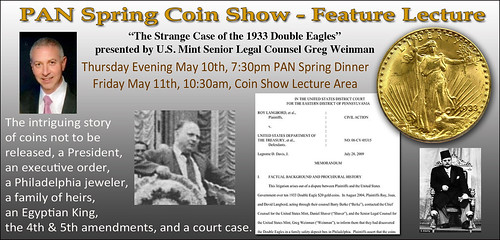
FAKE CANADIAN “DEVIL’S FACE” BACKSTORY
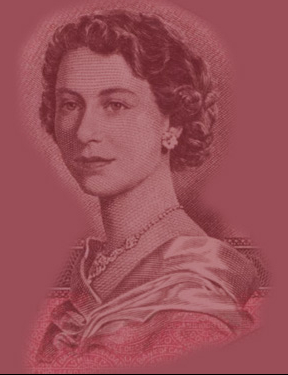 Web site visitor Mark Bellis is a professional photographer in Canada. He came across our 2014 account of the 1954 "Devil's Face" Canadian banknotes and offers this observation:
Web site visitor Mark Bellis is a professional photographer in Canada. He came across our 2014 account of the 1954 "Devil's Face" Canadian banknotes and offers this observation:
The source of the misinformation on the Devil's face two dollar Canadian note seems to have been a satirical article found here: http://www.agencetopo.qc.ca/
devilface/eng.html .
Peter-Dirk Uys was never a photographer, or even existed - it's just a misspelling of Pieter-Dirk Uys, a well-known South African comedian who was born in 1945. (They also misspelled Elizabeth throughout the article!)
The web site seems legit, but I agree with Mark's assessment - this looks like a bogus article. I was able to find nothing to back up the existence of the named photographer or the memoir he supposedly published. I'm sorry I didn't run down those leads at the time.
The notes remain controversial and we may never know if the optical illusion was created on purpose or by accident. We'll add a note to the article in our archive. Thanks, Mark. -Editor
Mark adds:
Personally I've never been able to see a real face in her hair, just some highlights that with a lot of imagination could be imagined to be a nose, eyes, etc. The highlights are in the original photograph of Princess Elizabeth taken in 1951 by Karsh of Ottawa, although the hair in the engraving made from the photo was modified to remove the tiara that she wore as a princess.

For more on journalist photographer Mark Bellis, see:
Mark Bellis (http://markbellis.blogspot.com/)
To read the earlier E-Sylum article, see:
THE 1954 “DEVIL’S FACE” CANADIAN BANKNOTES (http://www.coinbooks.org/esylum_v17n01a23.html)
CIVIL WAR TOKEN MAKER RESEARCH HELP SOUGHT
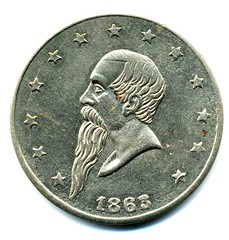 Starting in a serious way in the 1990s I gathered data relating to the creating and issuing of Civil War tokens. Some of this will be included in a forthcoming book for the Civil War Token Society, Engravers,
Minters, and Distributors of Civil War Tokens, subtitled, A source book for patriotic tokens, store cards, sutler tokens; histories, biographies, die details, and much more.
Starting in a serious way in the 1990s I gathered data relating to the creating and issuing of Civil War tokens. Some of this will be included in a forthcoming book for the Civil War Token Society, Engravers,
Minters, and Distributors of Civil War Tokens, subtitled, A source book for patriotic tokens, store cards, sutler tokens; histories, biographies, die details, and much more.
I stand on the shoulders of those researchers who have gone before, plus a number of modern scholars who have contributed to a book that will include much never before in print in a single volume.
The chapters on the larger companies are comprehensive—with S.D. Childs, William K. Lanphear, and John Stanton leading the field. In Connecticut the Scovill Manufacturing Co. made tokens in brass, but exactly which ones is a puzzle. More mysterious is the Waterbury Button Co., said to have made CWT, but no specific varieties can be attributed to them.
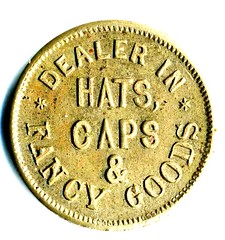
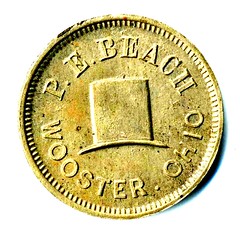
OH-975-A: P. E. Beach
Over 60 different engravers, coiners, and distributors will have individual chapters. Among these, here are some mysteries for which little is known about the people involved and what they did, as little has been found beyond their advertisements. If any E-Sylum readers can help, I would be very pleased!
Here is the list:
C. Barkley and John Maloney both had the same NYC address. Were these real people or are the names pseudonyms?
D. Mack is likewise mysterious—advertising at two NYC addresses and in Boston.
Francis Smith Edwards, M.D. is famous in the literature of early American coins as a maker of counterfeits of numismatic rarities, but did he ever make any CWT?
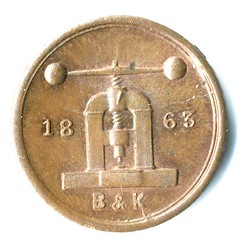 B&K is the name on a die featuring a hand-operated screw press. Was this a coining shop?
B&K is the name on a die featuring a hand-operated screw press. Was this a coining shop?
Neal & Enscoe in New York City is a mysterious partnership, and little is known of A. Ogden and S. A. Ogden at two addresses in the same city.
Charles F. Ulrick, Cincinnati engraver, was known to H.C. Ezekiel, who collected CWT in the 1860s, but I have not been able to learn anything about him.
J.E. Valentine’s biography is elusive as well.
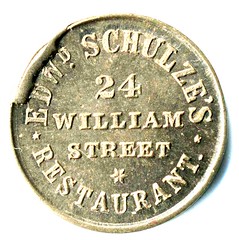
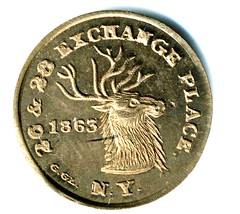
NY-630-BO: Edward Schultze's Restaurant
Then there is the Wooster Street coiner mentioned in an article published in The Numismatist, November 1932. The writer, Joseph Barnet, lived in Brooklyn and was the foremost dealer in and advertiser of Civil War tokens at the time, wrote multiple articles on the subject, gave talks to coin clubs, and mounted displays.
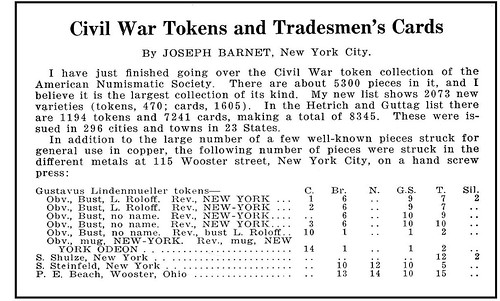
The vast majority of the ANS tokens came from the collection formed by Edward Groh, a pioneer enthusiast who obtained them at the time they were minted. The October 20, 1901, New York Times printed an interview with him in which he told of his collecting experiences over a period of decades, including this:
During the Civil War Mr. Groh made his famous collection of copperheads which he has since presented to the New York Numismatic Society. There are about 3,500 pieces in all, representing every state, town, and business house in which such coins were issued.
“It wasn’t necessary to approach a dealer for one of them,” said Mr. Groh. “I simply gathered specimens of those about me as they were issued, and I have corresponded and traded with collectors in all our Eastern towns and cities. Then after the war I traveled through the West, collecting and trading as I went. No, I don’t remember any remarkable experiences or histories concerned with them. There was very little of that sort of thing in coin collecting then.”
The Society had information about the minting of certain varieties in addition to those “struck for general use” at an earlier time. Perhaps there was or is a note with some of these varieties given by a donor other than Groh. Earlier, some of these restruck token varieties had been issued in quantities of many thousands for circulation. It seems that the dies had come into the hands of an unknown numismatist at a later time, who took them to someone at 115 Wooster Street in Lower Manhattan and had additional pieces struck. At one time there was a brass factory there, but details of it have not been learned. The restriking may have taken place after the Civil War at when time the usual CWT shops in Manhattan were no longer active.
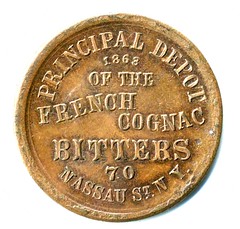

NY-630-BU: S. Steinfeld
Relevant to the above, a give a nod to Julie Casey, David Gladfelter, John Ostendorf, and David Schenkman who in recent weeks have solved several mysteries. Now, it is goal to go!
You can contact me:
Dave Bowers, qdbarchive@metrocast.net

MORE ON MEGA RED 4TH EDITION U.S. DIME COVERAGE
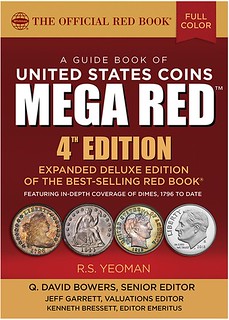 The John Reich Collectors Society, whose focus is on early U.S. silver and gold coins, was a useful resource for pre-1838 dimes. “Back issues of their John Reich Journal are a goldmine of information and can
make everyone an expert,” Bowers said. He called special attention to Barry Sunshine, a dedicated specialist of early dimes, who shared research and observations from longtime study. More than 50 pages are dedicated to
Draped Bust (1796–1807) and Capped Bust (1809–1837) dimes. This includes nearly 300 photographs (including enlarged photos of every date, plus many die varieties); mintages; commentary on the market, collecting tips,
physical characteristics, and other notes specific to each coin; certified population data (number certified, average grade, and percent in Mint State); and values in grades from About Good to multiple levels of Mint State.
Bowers also provides grading instructions (with high-quality enlarged photos of coins in grades from AG to MS, plus Proofs), history and background on each coin type, biographies of their designers and engravers, and guides
to collecting.
The John Reich Collectors Society, whose focus is on early U.S. silver and gold coins, was a useful resource for pre-1838 dimes. “Back issues of their John Reich Journal are a goldmine of information and can
make everyone an expert,” Bowers said. He called special attention to Barry Sunshine, a dedicated specialist of early dimes, who shared research and observations from longtime study. More than 50 pages are dedicated to
Draped Bust (1796–1807) and Capped Bust (1809–1837) dimes. This includes nearly 300 photographs (including enlarged photos of every date, plus many die varieties); mintages; commentary on the market, collecting tips,
physical characteristics, and other notes specific to each coin; certified population data (number certified, average grade, and percent in Mint State); and values in grades from About Good to multiple levels of Mint State.
Bowers also provides grading instructions (with high-quality enlarged photos of coins in grades from AG to MS, plus Proofs), history and background on each coin type, biographies of their designers and engravers, and guides
to collecting.
Bowers’s coverage of Liberty Seated dimes (1837–1891) is similarly detailed over the course of 90 pages, and illustrated by 457 large-sized photographs of this long-running series’ coins, plus historical images. Bowers spent many hours studying the availability of each coin in various grades. He gives a great amount of advice and guidance on smart buying and collecting, and shares insight and research from the Liberty Seated Collectors Club and other specialists.
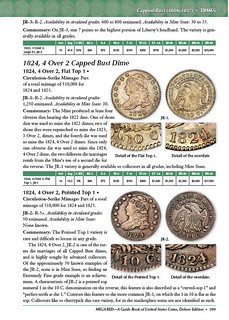
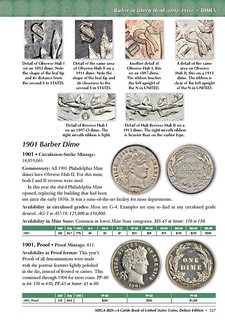
For Barber dimes (1892–1916) Bowers presents another full guide to collecting, grading, history, surviving populations in circulated, Mint State, and Proof formats, die varieties, hub changes, strike sharpness, and other factors relevant to collectors. He consulted with John Frost, Phil Carrigan, and other members of the Barber Coin Collectors Society for research into each date and mint. Certification data and retail price charts show the market for coins from Good-4 up to Mint State–65, plus Proofs at multiple levels. Barber dimes comprise 42 pages of research and 241 photographs, including close-ups of die-variety diagnostics.
Winged Liberty (or “Mercury”) dimes of 1916 to 1945 make up 40 pages of the expanded catalog. Bowers explains the changeover from Barber coins to the new design, including patterns, release and distribution, and the public’s perception. His coverage of strike characteristics, Proof Mercury dimes, grading standards (including for Full Band details), retail prices in 12 grades, population data, die varieties, marketplace factors, and other details give collectors plenty to study. Bowers consulted with David W. Lange, Bill Fivaz, and other specialists for in-depth research. The coin-by-coin study is illustrated by 123 photographs, including many die-variety enlargements.
For Roosevelt dimes, Bowers lays out the history of the coin developed to honor President Franklin Roosevelt, who led the nation out of the Great Depression and through most of World War II, dying of a cerebral hemorrhage just weeks before Germany and Japan surrendered. Bowers gives an illustrated biography of Roosevelt, a history of the coin’s design (including the controversy over artist Selma Burke’s claim to be its designer), and information about production, hub changes over the years, tips for collecting, and grading standards (including for Full Torch details). His coin-by-coin study covers silver Roosevelt dimes of 1946 to 1964, including Proofs, plus the mysterious 1964 Special Mint Set coins. He discusses 1965–1967 SMS coins, and popular die varieties listed in the Cherrypickers’ Guide. Copper-nickel and silver Roosevelt dimes of 1965 to date are explored in charts and photographs of each. In total, 67 pages and 575 photographs are devoted to these popular modern coins.
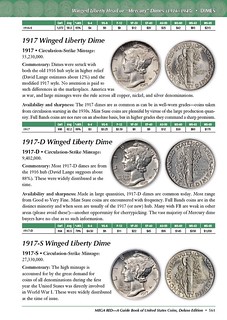
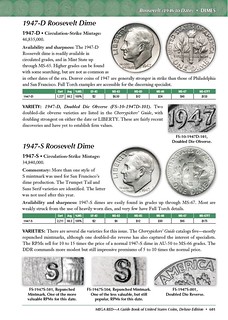
In addition to these detailed studies of individual dimes, of MEGA RED’s 25 appendices Bowers coordinated 15 that each focus on a specific dime-related topic. The richly illustrated “Carpe Dime! Dimes Seize the American Imagination,” by award-winning numismatic author Joel Orosz, explores dimes in popular culture ranging from music to literature, movies and other entertainment, commerce, banking, and other aspects of life in the United States. Other appendices show extraordinary error and misstruck dimes; pattern dimes and proposals that never became official coins; counterstamped dimes; dime scrip issued by banks, merchants, and towns; “paper dimes” from the U.S. Treasury Department; Civil War sutlers’ “dime” tokens; Civil War ten-cent store cards and dimes used as planchets for silver Civil War tokens; dimes recently discovered in the purser’s safe of the shipwreck SS Central America; the history of the famous 1894-S dime; a snapshot of the dime market in the 1940s; irradiated dimes; and an illustrated essay on the greatest U.S. dimes.
“With more than 1,600 high-quality photographs of U.S. dimes, this edition of MEGA RED is like having six beautiful coin collections laid out in front of you for in-depth study,” said Bowers. “Add to that 80 pages of related appendices with an additional 250-plus photographs, and you cannot afford to miss out on this edition.” Images are from the Whitman Publishing historical archives plus coins photographed by Heritage Auctions, Stack’s Bowers Galleries, NGC and PCGS, the Smithsonian, and individual hobbyists who answered Whitman’s call for dime photographs.
MEGA RED is billed as the “biggest, most useful Red Book ever.” It measures 7 x 10 inches and has 1,040 more pages than the regular edition. The larger size and increased page count combined make MEGA RED five times bigger than the regular-edition Red Book. It prices more than 8,000 items in up to 13 grades each, with 48,000 individual values and more than 15,000 auction records covering circulated, Mint State, and Proof coinage. The book is illustrated with thousands of full-color images, including thousands that are new to this edition.
For more information, or to order, see:
https://www.whitman.com/store/Inventory/Detail/MEGA-RED-A-Guide-Book-of-United-States-Coins-Deluxe-4th-Edition+0794845800
To read the earlier E-Sylum article, see:
NEW BOOK: MEGA RED 4TH EDITION (http://www.coinbooks.org/v21/esylum_v21n13a04.html)
NUMISMATIC POETS SOCIETY AWARD
The Numismatic Poets Society Presents Best Poem Awards at the 2018 Georgia Numismatic Association Coin Show
At the 2018 Georgia Numismatic Association Coin Show there was a special award available to exhibitors; the Numismatic Poets Society sponsored “Best Poem Award.” The award can only be won once and includes a lifetime membership in the NPS. This award was won by Cole Jones. His exhibit was in the Junior Category titled “Have You Heard of Me?” His exhibit included his original poem called Unusual Coins. The Numismatic Poets Society provided a 2018 Proof American Silver Eagle for this Award. John Phipps, NPS Founding Member, presented this prize at the YN Program on Saturday afternoon at the show.
Unusual Coins by Cole Jones
When collecting rare coin
Don’t use them to buy a tenderloin
At a coin Show, go to the bourse
Where you can find some great coins, of course
I have a half-cent
Although it’s a little bent
All these coins were minted in Philadelphia
If you see another mark it would cause hysteria
I heard you wanted a two-cent
Check the mail because it was just sent
The first appearance of “In God We Trust”
Could have seen a little bit of dust
I really need that special trime
And it better be sent on time
Have you ever seen a six pointed star?
Then look at this coin from afar.
If you ever want a three-cent nickel
You’ll have to sell a lot of pickles
Do you have a wreath for my coin?
Three roman numerals will have to join
Do you have my half-dime?
I would like it without slime
Would you like to be late?
Well that was this coin’s fate
To buy a twenty-cent
You’ll have to save some of your rent
You see Lady Liberty on a rock?
Well, I hope she isn’t in your sock
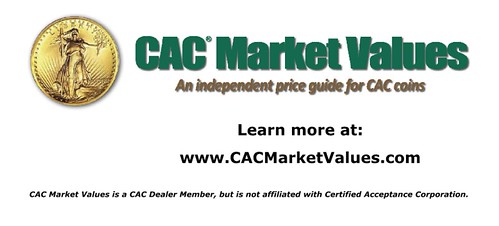
VOCABULARY TERMS: ADJUSTING, ADJUSTMENT

This view is the adjusting room at the Philadelphia Mint. Women were hired for their finger dexterity. They could weigh a blank then remove just the right amount of metal from an overweight blank, then weigh it again, often in a minute's time.
Image from the David Sklow numismatic postcard collection via the Newman Numismatic Portal
Postcard text:
The Adjusting Room U.S. Mint, Philadelphia. In this scene, circa 1903, nearly sixty women, seated at tables in long rows, each before a fine balance, weigh and adjust blanks and coins. If a coin was found slightly heavy, it was filed a little from the edge until they were made the proper weight. Others found too light, or too heavy for filing, were returned to be melted.
Adjusting, Adjustment. Working a blank or partially struck piece, usually by hand, to proper tolerances of size, weight or temper prior to final striking. Adjusting the blank is a preparatory step for striking coins, it precedes all other preparatory steps including UPSETTING, ANNEALING and METAL CLEANING of coinage blanks.
Adjusting coin blanks to proper weight was a common practice for precious metal coinage blanks prior to the 20th century, particularly for mints with primitive equipment. It also continued for gold blanks even into the 20th century. Overweight blanks were shaved or filed of enough metal to reduce the weight to proper TOLERANCE. Underweight blanks were rejected, excepted for REGULATED COINS, a primitive attempt to add gold to underweight struck coins.
The reason for blanks varying so greatly in weight was the lack of precision ROLLING MILLS. It was not until the automatic micrometers were installed on mills that strip could be rolled to a precise thickness. Then technology for BLANKING became so developed in the last half of the 20th century that blanks could be created with precision to .01 of a gram. Manual adjusting was no longer necessary.
How blanks were adjusted. For more than a century, weight adjusting was done with a file and a balance scale. In America this was done by women who would make the decision where to file each gold blank. With dexterous fingers they would file off burrs at the rim/edge juncture, and if more was required, from the circumference of the edge, or from the flat surface of the blank. Evidence of this filing, observed on the piece after it was struck, is called ADJUSTMENT MARKS.
With experience, adjusters could judge how much to file off after first weighing on a balance scale. This done, the blank would be weighted again. It was necessary to reduce the weight within the prescribed tolerance. Mostly this was done for gold blanks (the salvaged metal could justify the cost of manual workers), but some large silver coins have been observed with adjustment marks as well.
The adjusters wore leather aprons to catch the filings, as the intent was to salvage as much gold as possible while still providing legally prescribed correct weight blanks. Even so, their clothing, sweepings and wash water were carefully processed to recover the tiniest speck of gold.
History of adjusting. For hammer coinage prior to the 14th century some adjusting was done in the preparation of blanks. They had to be circular shape, the correct size and fairly uniform thickness. If not, another hammer blow was administered. But it was the demand for coins of close tolerance in the 19th century that gave rise to extensive manual adjusting after planchets were blanked in quantity.
The first gold coins struck at the recently established U.S. Mint at Philadelphia in 1794 exhibit adjusting. Breen states the first women hired at the mint were adjusters and that numismatists do not consider these adjustment marks on coin surfaces as impairments.
An account in 1853 told of 57 young girls working in the adjustment room in the Philadelphia Mint. It stated that they adjusted 40,000 blanks in a 10-hour work day (requiring less than a minute per blank!). Coin making authority Dennis Cooper reports more than 200 adjusters employed in the Berlin mint prior to 1870, and shows an illustration of a dozen adjusters (of both sexes) working in the Royal Mint, London.
Cooper also illustrates a machine for mechanical adjusting (developed by Pilcher and Jones, an English firm which made minting equipment). A quantity of blanks, perhaps 40 or 50 were placed in a roll. A circular file rotated as the blanks revolved around the file. The shavings dropped into a glass dish below.
In addition to this machine, Cooper also illustrates a clamp to hold blanks for manual scraping the surface, and two devices to do this mechanically. While somewhat ingenious, the first machine was, for the most part, impractical, since it could not customize the filing for each blank. It was far easier to do individual blanks manually, with or without the holders shown.
Mechanical scales, invented by Austrian Ludwig Seyss in 1871, dramatically affected adjusting. Prior to this time all weighing was done manually. After 1871 weighing could be done ten at a time on Seyss automatic scales with tolerances set to sort blanks in three hoppers: under legal limit, within legal limit and over legal limit.
Labor costs were such that it was cost effective to adjust only gold overweight coin blanks early in the 20th century. Otherwise precious metal blanks over and under legal limits were sent back to the furnaces to be remelted.
Modern adjusting. Overweight blanks intended for gold coins, medals – or bullion coins! – are just as much a problem in the 21st century as it was in the 19th century. Once planchets have been blanked and weighed, the overweight blanks are separated, then rolled diagonally across a fast-moving belt of aluminum oxide. They are weighed again to check tolerance and if still overweight they are treated again. The dust from the aluminum oxide belt is salvaged as coinage alloy gold.
Temper adjusting of medals. Adjusting to temper is somewhat more difficult than shaving or filing off metal. HEAT TREATING will alter the temper, but in some instances, as in the case of DIE DRAW, where the metal
flows into, then out of a die cavity in succeeding strikes during MULTIPLE STRIKING, the temper must be adjusted – by sharp hammer blows to the edge of the partially struck piece! The hammer blows impact the FLASH (later to
be removed) but this jolts the surface molecules enough to allow the metal to flow back into the die cavity during the final press striking.
CLASS 06.2
References:
C66 {1988} Cooper, p 202-04.
CH5 {1853} Anonymous.
NC8 {1988} Breen, p 373.
To view the image on the Newman Numismatic Portal, see: U.S. Mint Postcard (Interior View) (https://nnp.wustl.edu/library/ImageDetail/516943)
Looking for the meaning of a numismatic word, or the description of a term? Try the Newman Numismatic Portal's Numismatic Dictionary at: https://nnp.wustl.edu/library/dictionary
VIDEO: ROBOTS AT THE SAN FRANCISCO MINT
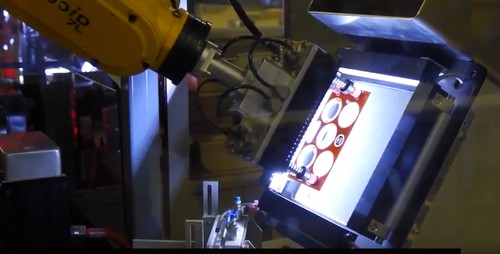
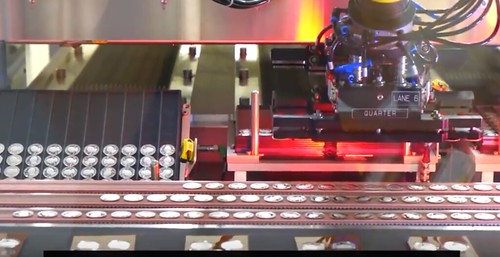
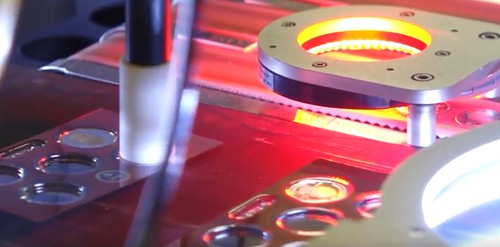

To watch the complete video, see:
High Tech Robots at the San Francisco Mint (https://www.youtube.com/watch?v=BqEDQa0WGf4)
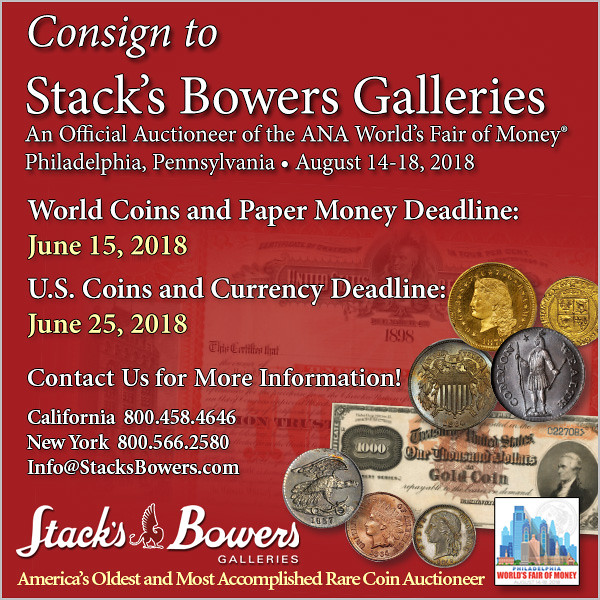
NéSTOR PONCE DE LEóN Y LA GUARDIA (1837-1899)
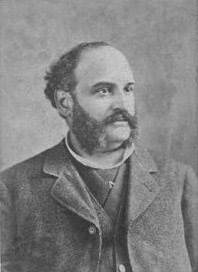 Néstor Ponce de León y La Guardia (1837-1899), was born on February 26, 1837, at Habana, Cárdenas region, Matanzas province, Cuba, son of Cirilo Ponce de León Espinosa, and Mercedes de la Guardia.
Néstor Ponce de León y La Guardia (1837-1899), was born on February 26, 1837, at Habana, Cárdenas region, Matanzas province, Cuba, son of Cirilo Ponce de León Espinosa, and Mercedes de la Guardia.
In 1858, he graduated with a degree in Juisprudence.
In 1865, he donated a copy of a book on Spanish royal medals : Ensayo de un catálogo descriptivo de las medallas de proclamaciones de los Reyes de España, por Hipólito Pérez Varela. (Habana, imprenta Nacional y Extranjera: 1863). He was unanimously elected as a Foreign Corresponding Member of the Numismatic and Antiquarian Society of Philadelphia.
He and his family fled the Cuban police who had a warrant for his arrest publishing revolutionary pamphlets defending the Yara Revolution and arrived in New York City, New York, in February 1869.

In New York he practiced law and was a bookseller and publisher. He also was the founder of the Central Revolutionary Board of Cuban Immigrants. He was a great advocate and aid to José Martí.
On January 21, 1875, he became a naturalized citizen of the United States of America.
On January 16, 1877, he was elected a resident member of the ANS.
In 1877, he published a Fixed Price List, Catalogue of a Large Collection of Roman and Greek Coins.
He died on December 17, 1899, at Habana, Cuba.
To read the complete article, see:
PONCE DE LÉON Y LA GUARDIA, NÉSTOR
(https://sites.google.com/a/numismaticmall.com/www/numismaticmall-com/ponce-de-leon-y-la-guardia-nestor)
The entire inventory of the Lupia Numismatic Library is for sale. Individual items will be available before the remaining archives are broken up into parcels sold at philatelic auctions in the U. S. and Hong Kong. Check NumismaticMall.com frequently as dozens of new items with estimates will be posted daily until everything is sold.
All inquiries will be given prompt and courteous attention. Write to: john@numismaticmall.com .
ROSE M. TETTENHORST (1936-1989)
Rose M. Tettenhorst (nee Huehnerhoff) was married to Dale J. Tettenhorst (1935-1978). She worked as an administrative assistant at Edison Brothers Stores, Inc. in St. Louis. Her boss was president of the company, Bernard Alan Edison.
Rose was active with the International Association of Administrative Professionals (IAAP) on the local, national and international levels. Following her death, the local chapter named an annual award in her honor.
Her boss was a coin collector who desired some anonymity for his coin transactions. Invoices were addressed to Rose M. Tettenhorst or R. M. Tettenhorst. Eventually he adopted the pseudonym R. Tettenhorst for his collecting interests.
When Rose died in 1989, word of her death came to the attention of some collectors who were familiar with the R. Tettenhorst name. There was some brief confusion from those who thought it was the half cent collector who had died.
HARVEY STACK'S NUMISMATIC FAMILY, PART 16
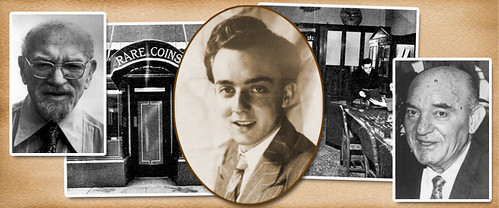
It was essential that Stack's have the very best cataloging for the large cents. To do this, my father and uncle contacted Dr. William Sheldon, who in 1949 had published the definitive book entitled Early American Cents. Dr. Sheldon had studied most of the important collections during the time he had worked on the book. He condensed the information about dates and varieties, set up a new numbering system for the coins (Sheldon numbers) and a new grading system using adjectival and numerical grades in tandem. This revolutionized the entire classification and collecting of large cents.
Dr. Sheldon was a close friend of both senior Stack's and so they approached him and showed him the two large cent collections. To him this was the find of the century, for neither of these collections had been seen earlier by him. Dr. Sheldon remarked after he saw both collections that they would force him to revise his earlier book and make a new Condition Census to guide cent collectors. He said that he would love to catalog the cents and my father replied that if Dr. Sheldon could get it done in time for sales in 1954 he could have the job. They shook hands and the deal was made.
Dr. Sheldon lectured till about 5 PM at Columbia University each weekday. We made a schedule and a plan and I was put in charge of getting the work done. Dr. Sheldon would come to our offices on the days he could and have dinner in our shop (the Hotel Salisbury in our building had room service and we could order ahead). He worked from about 6 PM until 10 PM three times a week, and on Saturdays from 10 AM to 3 PM. C. Douglas Smith, an early date specialist, (who was a speed typist) was selected to work with him and help prepare manuscripts. Being in charge of this I saw less of my family, but with Uncle Joe often on the road and my father working everyday until dinner time, it was my job to retrieve the coins from the safe for the catalogers who worked at a desk across from me. I was to work with both of them to learn more about cents and, time permitting, I did some cataloging of the other coins in each collection. I learned a lot, having these two great large cent specialists as my teachers and hearing the discussions they had with each other.
Since we planned to sell the Davis-Graves Collection first, we focused on those coins. The Davis-Graves Collection was unusual; it basically had one coin each year as its goal, from the half cent to the silver dollar, and in gold from the $1 to the $20. While in certain series it had mintmarked coins, the goal was not a complete set including all mintmarks, but one coin for each year. It was an unusual way to collect, but that was how it was done. Additionally, it had an extensive collection of Pioneer and Territorial gold, and a wonderful collection of gold and silver coins of the world, highlighted by a Polish 100 gold ducat of 1621. The Davis -Graves sale was one of great variety and quality, and it attracted hundreds of floor bidder and record mail and phone bids.
The first sale was held in March at Steinway Hall, the concert hall that was one of Stack's neighbors on 57th Street. During this auction I met many new collectors and dealers and became friends with a budding young dealer, who was just starting out. It was Q. David Bowers. He was bright and wanted to learn how a firm like Stack's functioned. Prior to each session of our sales, David would pitch in and help us carry the needed auction material from our shop to the auction room, and even help set it up. When each session was over, Dave would help the staff pack up and take the material back to our offices. We became close friends, not knowing that over 50 years later we would have joined forces in the company that is Stack's Bowers Galleries today.
To read the complete article, see:
Harvey Stack Remembers: Growing up in a Numismatic Family, Part 16 (http://www.stacksbowers.com/News/Pages/Blogs.aspx?ArticleID=2935)
To read the earlier E-Sylum article, see:
HARVEY STACK'S NUMISMATIC FAMILY, PART 15 (http://www.coinbooks.org/v21/esylum_v21n14a16.html)
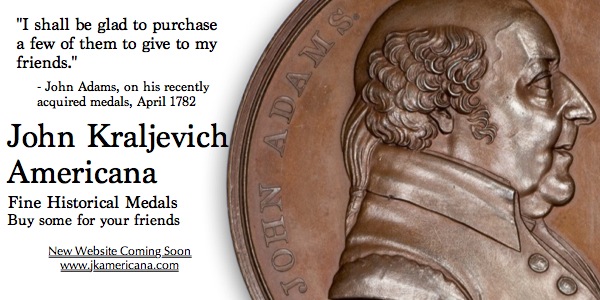
ANA SEEKS PHILADELPHIA MONEY TALKS SPEAKERS
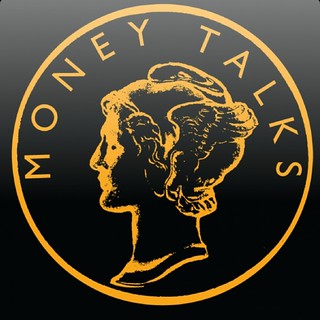 American Numismatic Association (ANA) members are encouraged to share their ideas and research with fellow hobbyists by delivering a Money Talks presentation at the 2018 World’s Fair of Money in Philadelphia, Aug.
14-18 at the Pennsylvania Convention Center.
American Numismatic Association (ANA) members are encouraged to share their ideas and research with fellow hobbyists by delivering a Money Talks presentation at the 2018 World’s Fair of Money in Philadelphia, Aug.
14-18 at the Pennsylvania Convention Center.
Those interested in giving a Money Talks presentation should submit an online proposal at www.money.org/numismatic-events/money-talks. Proposals are due no later than May 16.
The informative 30- to 45-minute presentations are presented by some of the hobby's most noted authorities and allow collectors to share their expertise with the numismatic community. Presentations from previous shows include “The Fugio Cents of 1787,” “Collecting Medals,” and “Curious Currency of the World.”
Money Talks presentations should be accompanied by digital images or slides. Speakers should arrive 15 minutes prior to their presentation to set-up.
Contact Sam Gelberd, the ANA's numismatic educator, at (719) 482-9846 for additional information. Proposals can be submitted online or emailed to sgelberd@money.org
The World's Fair of Money is one of the largest, most educational coin shows in the country and features nearly a thousand numismatic dealers with extensive inventories. The show also includes a wide range of technical seminars and educational presentations; an exhibits area; major auctions by Heritage Auctions and Stack's Bowers Galleries; and the ANA Museum Showcase, exhibiting some of the world's most rare and valuable coins and paper money. For more information, visit www.worldsfairofmoney.com.
PEABODY MUSEUM EXHIBITS CALIFORNIA GOLD
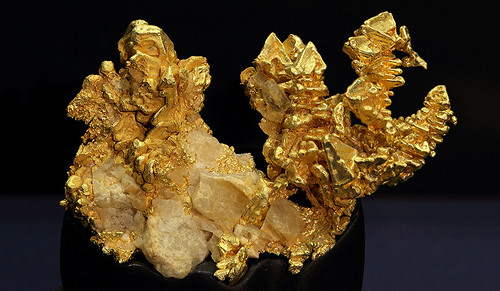
The Yale Peabody Museum of Natural History is having a gold rush — one in which prospectors can gaze at glittering specimens of radiating golden leaves.
An exhibit opening at the museum on Saturday, April 14, will showcase 23 pieces of California gold, including unusually large examples as well as smaller ones featuring extremely rare crystallographic forms.
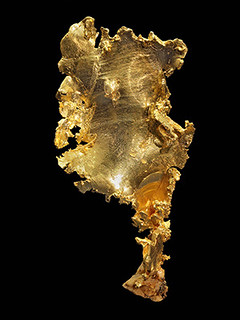 “This collection is incredible,” said Richard Kissel, the Peabody’s director of exhibitions and public programs. “The gold specimens on view are of superior quality — impressive physically and stunning
aesthetically. The exhibit highlights the specimens’ beauty while offering insight into the history and science of gold mining.”
“This collection is incredible,” said Richard Kissel, the Peabody’s director of exhibitions and public programs. “The gold specimens on view are of superior quality — impressive physically and stunning
aesthetically. The exhibit highlights the specimens’ beauty while offering insight into the history and science of gold mining.”
Several of the specimens on display resemble gilded coral formations: Leaves of gold overlap, intersect, and form jagged branches. The largest specimen measures about a foot across. Most were mined over the past 25 years, although two specimens of crystallized gold were mined in the 1850s during the California Gold Rush.
The exhibit also features a collection of historical instruments and artifacts related to gold mining in California, including a mining pan filled with gold dust, a balance for weighing specimens, an instrument for measuring the velocity of air in mines to ensure proper ventilation, a field chemical lab called a “blowpipe kit,” and a silver candlestick decorated with mining-related symbols that miners used for illumination while underground.
To read the complete article, see:
Peabody showcases ‘stunning’ specimens of California gold
(https://news.yale.edu/2018/04/12/peabody-showcases-stunning-specimens-california-gold)
SS CENTRAL AMERICA GOLD NUGGET MEDALS
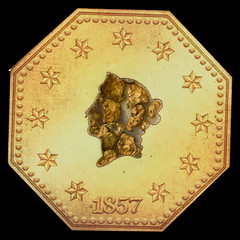
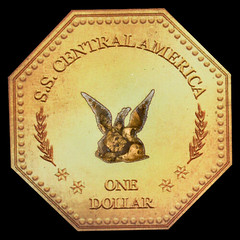
In 1857, 30,000 pounds of gold were sent from San Francisco to the East Coast by sea…and never made it. A hurricane sunk the S.S. Central America, and all that wealth vanished, not to be seen again for over a century. The sinking contributed to the Panic of 1857, a major financial crisis.
When the S.S. Central America was discovered, it was one of the great shipwreck finds of the century. Amidst all that wealth were real California gold nuggets, mined by those very miners who risked so much.
Today we offer you those nuggets: real, California gold rush nuggets, buried at the bottom of the sea for over 100 years. The nuggets are encapsulated in a custom-made medallion with Lady Liberty on one side and an eagle on the other.
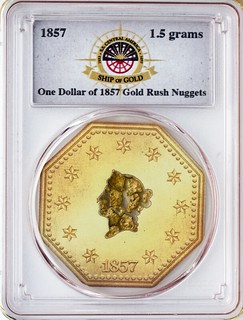
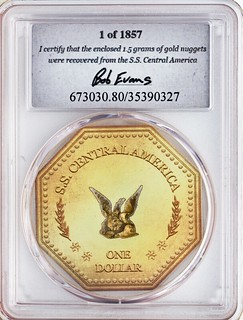
For more information, or to order, see:
1857 $1 SSCA 1.5 Grams Gold Nuggets (https://www.blanchardgold.com/product/1857-1-ssca-1-5-grams-gold-nuggets/)

MINT TO EXHIBIT 1933 GOLD DOUBLE EAGLE AT PAN
The infamous 1933 gold double eagle has been in the news many times in recent years, most recently when the family of 1930s Philadelphia jeweler Israel Switt brought 10 specimens to light – all later confiscated by the Secret Service after lengthy litigation. While 445,000 examples of the 1933 double eagle were struck by the United States Mint, Executive Order 6102, issued by President Franklin Delano Roosevelt to effectively ban private gold bullion ownership, was enacted before the 1933 double eagles were officially issued by the United States Mint.
All were officially recalled and melted, save for two specimens that went to the Smithsonian and several others that wound up in private hands. Presently, only one specimen – the King Farouk 1933 gold double eagle – is in legal private possession. At this time, all of the rest, including the Switt specimens, are considered illegal for private citizens to own.
The litigation matters surrounding the 1933 double eagle is the topic that United States Mint Senior Legal Counsel Greg Weinman will discuss at LeMont restaurant in Pittsburgh, Pennsylvania on May 10 at 7:30 PM and May 11 at 10:30 AM at the PAN Coin Show Lecture Area at Monroeville Convention Center, 209 Mall Plaza Boulevard, Monroeville, PA, 15146. Weinman and the US Mint will be exhibiting a 1933 gold double eagle during the PAN Spring Coin Show, which runs May 10-12, so this is an excellent opportunity for dealers, collectors, and others to see one of the rarest and most controversial coins in person.
The 1933 gold double eagle is not only one of the rarest US coins, but it’s also one of the most valuable. When the single “legal” private specimen – the King Farouk 1933 gold double eagle – crossed the auction block in July 2002, it commanded $7,590,020, which at the time made that coin the most expensive ever sold at auction. That amount has since been eclipsed by only the 1794 Flowing Hair dollar, which reportedly took $10,016,875 at auction in January 2013.
For more information about the PAN show, see:
https://pancoins.org/
CANADIAN-AUSTRALIAN MINT LAWSUITS ESCALATE

Royal Australian Mint’s Possum Magic coins
The Royal Canadian Mint has demanded that its Australian counterpart destroy a set of coloured coins celebrating the popular children’s book Possum Magic amid a legal battle over rights to the process used to create them.
A lawsuit filed in December in Australia’s federal court alleges that the Royal Australian Mint had – without permission – used a patented method of printing colour on metal to print 500,000 commemorative Remembrance Day $2 coins featuring a red poppy.
The Canadians said they had flagged the patent issue two years earlier, only to have their concerns met with an assertion that the method being used in Australia was “sufficiently different to have not infringed” the patent.
The Canadian mint eventually took its complaint to the Australian courts, demanding that any coins not yet in circulation be either turned over or “destroy[ed] under supervision”, according to the National Post.
The lawsuit launched by the Canadian crown corporation also seeks to force Australian mint – which is part of the Australian government – to surrender any profits and pay damages.
Recently, the Canadian mint expanded its lawsuit to include several other $2 coins, including a 2017 release featuring designs from Possum Magic and Olympic-themed coins.
While the coins in question include 12 colourful designs printed on an estimated 15m coins, the Canadian mint said it is not seeking the destruction of any coins already in circulation.
Their demands have been countered with another lawsuit – this week the Australian government filed a counter claim asking that the Canadian patent be declared invalid on the grounds that it is not enough of a “novelty” over what has been done previously.
To read the complete article, see:
Canadian mint sues Australian mint over magic possums and red poppies
(https://www.theguardian.com/world/2018/apr/18/royal-canadian-mint-sues-australia-possum-magic-coins)
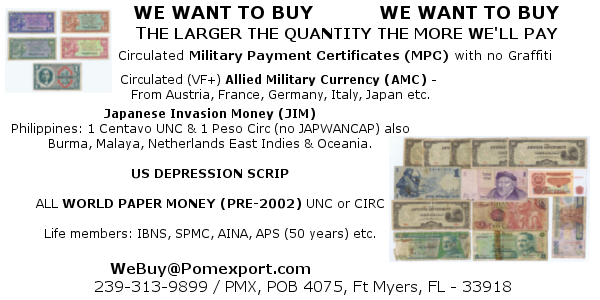
WHAT HAPPENED TO THE HARRIET TUBMAN PLAN?

When a Harriet Tubman scholar found out in 2016 that the abolitionist she studied for decades was going to be the new face of the $20 bill, she cried.
“Here you have an African American woman, formerly enslaved who fought and struggled her whole life for freedom and equality.” Kate Larson said.
But Larson and others eager to withdraw Tubmans from the bank may have to wait longer than expected. Two years ago this week, Treasury Secretary Jack Lew announced redesigns for the $20, $10, and $5 bills that would honor civil rights and women’s rights icons: Tubman, Alice Paul, and Marian Anderson. Lew said the new note designs would debut by 2020, 100 years after women gained the right to vote.
But now the Trump administration is putting the plan on the backburner, according to the Treasury department.
A spokesperson for the Bureau of Engraving and Printing told The Daily Beast that the redesigns have not been finalized or approved for circulation. The next note set to be released is the $10 bill, and the redesign won’t enter circulation until 2026, according to a spokesperson.
Before Lew’s announcement, the Treasury Department’s Advanced Counterfeit Deterrence Steering Committee signaled that a new $10 bill would be rolled out first, followed by the $50 bill, and then the $20 bill. The release dates for all the new notes could be pushed back even further to fight counterfeiting, according to a spokesperson. That means the public may not see the Tubman $20 bill until years, even decades after the original 2020 design release date.
To read the complete article, see:
What Happened to the Plan to Put Harriet Tubman on the $20 Bill?
(https://www.thedailybeast.com/what-happened-to-the-plan-to-put-harriet-tubman-on-the-dollar20-bill)
DLUGOSZ SPRING 2018 PRICE LIST SELECTIONS
The offering features a selection of high quality 18 and 19th century British tokens and British historical medals including sought-after Thomas Paine and anti-slavery motifs, as well as a handful of hard-to-find 19th century American political tokens and medals e.g. Baker-282 and a brilliant example of the 1840 American Anti-Slavery Society medal.
In 1739 Richard Howe entered into the service of the Royal Navy. From the age of 13-18 he served as a midshipman – a voluntary position where young men trained to become officer. Having gained sufficient experience by 1744 he was given the post of commissioned lieutenant.
Howe spent another 55 years climbing the ranks and fighting in naval battles during the most notable conflicts of his era: the Seven Years War, the American Revolution, and the French Revolution. On what became known as the Glorious First of June, then Admiral Lord Howe, commanded his fleet to perform an unconventional maneuver. This was executed somewhat haphazardly. The British succeeded insofar as the French fleet incurred the greatest damage. However, the ultimate goal of intercepting a vital convoy of supplies from the United States to France was not achieved. As a result both Britain and France were able to lay claim to victory back home.
Most of the halfpenny tokens bearing Howe's likeness are medallets made for sale by Peter Kempson out of Birmingham. Kempson's business as a manufacturer of buttons and medals was active from the 1790s through 1826.
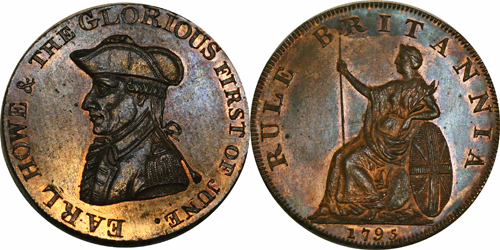
#4. Hampshire 21. Copper halfpenny. Obverse: EARL HOWE & THE GLORIOUS FIRST OF JUNE. Reverse: RULE BRITANNIA 1795. Gem Uncirculated with flashy prooflike surfaces and remaining mint red.
Thomas Frederick Salter owned a hatter's business at 47 Charing Cross in London. He issued this general trade token for that operation in the 1790s. The man's real passion in life was to go fishing. Salter was introduced to the sport by his father at the age of 12 and spent most of his spare time during the ensuing 40 years fishing in locations around the county of Middlesex, " remaining at favourite stations for weeks together."
In 1814 at the age of 52, he published his first book on the subject. It would go through 9 editions. The Angler's Guide, Being A Complete Practical Treatise on Angling: Containing the Whole Art of Trolling, Bottom and Float Fishing, Fly-fishing, and Trimmer-angling for Sea, River and Pond Fish, Founded on Forty Year's Practice and Observation. (Personally, I'm partial to pond fishing for bass with an extra line sitting on the bottom for cats).
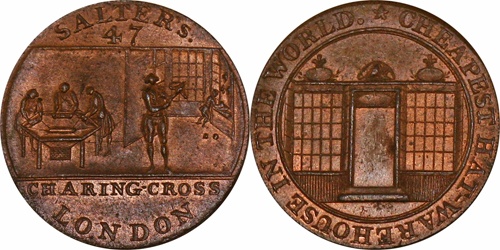
#12. Middlesex 473. Copper halfpenny. Obverse: A view inside Salter’s hat maker workshop. Reverse: CHEAPEST HAT WAREHOUSE IN THE WORLD. Gem uncirculated. Excellent strike. Lots of mint red.
During the 17th and 18th centuries the town of Burslem in Staffordshire grew into a center for the production of pottery due to a significant deposit of clay that runs through the area. Here, Josiah Wedgwood he began working in the family business at the age of 9 under his brother, Thomas, a 3rd generation master potter. J.Wedgwood became a master potter as well and later ran an immensely successful operation on the grounds of his own estate, Etruria.
Around 1787 he began producing porcelain medallions for the Society for the Abolition of the Slave Trade that featured the infamous kneeling slave motif. Wedgwood's factory is largely responsible for the initial proliferation of that image and in part increased public support for the abolition of the Atlantic slave trade. The design was used by artists who worked in a variety of mediums, including manufacturers of British tokens and medals from the 1790s through the mid 19th century. It was later borrowed by the American Anti-Slavery Society (1833-1870).
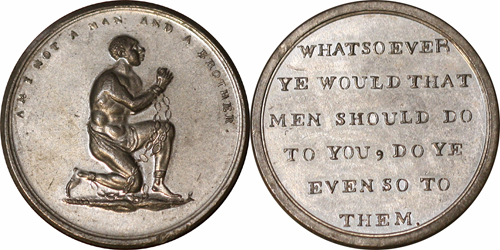
#8. Middlesex 235 bis III. White Metal. Obverse: A slave kneeling, AM I NOT A MAN AND A BROTHER. Reverse: WHATSOEVER ... This specimen fresh to the market having been in a private collection for over 30 years. A tiny imperfection at the rim otherwise choice uncirculated with lots of mint brilliance. Not easy to find specimens with fields this nice.

#34. Middlesex 1089. Copper farthing. Obverse: Adam & Eve, MAN OVER MAN HE MADE NOT LORD. Reverse: A slave kneeling, AM I NOT A MAN AND A BROTHER. Gem uncirculated. A superb specimen with a very strong strike for this issue - slightly broadstruck. Mint red on the periphery fades into bluish brown toning toward the centers. Unimprovable!
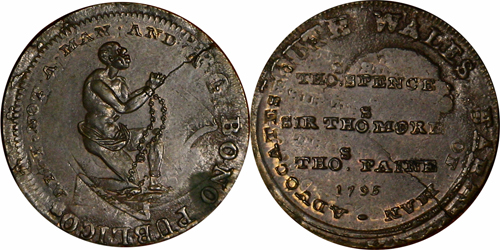
#35. Middlesex 1118 double-struck over South Wales 23. Copper farthing. Obverse: THOS SPENCE, SIR THOS MORE, THOS PAINE. Around, NOTED ADVOCATES FOR THE RIGHTS OF MAN. The host token, South Wales 23, rotated about 35 degrees clockwise and struck once, then rotated another 15 degrees clockwise and struck again. Reverse: A slave kneeling, AM I NOT A MAN AND A BROTHER. The top part of the shield and most of the reverse legend from South Wales 23 is boldly visible. Uncirculated. Toned brown with some brassy mint brilliance clinging tightly to the lettering and a small tone spot noted. An unusual and unique twist on top of an already very hotly collected design. One of a kind.
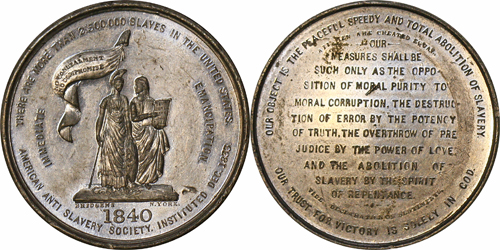
#44. 1840 American Anti-Slavery Society Medal. White Metal. By New York engraver William Henry Bridgens. Rare and sought after. Despite a few minor marks, this medal is brilliant and flashy uncirculated with bold strike—two characteristics that I have never seen together for this variety. Specimens that possess just one of those qualities command strong prices.
To read the complete fixed pricel list, see:
http://condertokenbook.com/fpl

NUMISMATIC NUGGETS: APRIL 22, 2018
1814 George III Indian Peace Medal
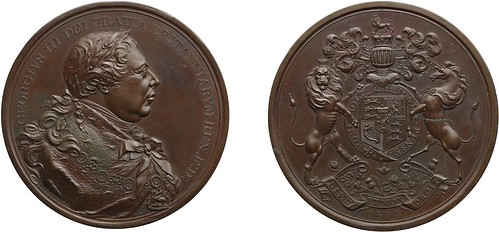
Great Britain, George III (1760-1820), Indian Peace Medal, 1814
Bronzed copper. Large size. GEORGIVS III – DEI GRATIA BRITANNIARVM REX.FID:, laureate and mantled bust of George III right, on truncation, T.WYON.JUN:S:, rev., HONI SOIT QUI MAL Y PENSE – DIEU · ET · MON · DROIT, royal arms; below, 1814, 75.6 mm (Adams 12.1, no. 39, this piece), struck on a thick flan, with small patches of roughness behind the head and to the lower right of the reverse, and evidence of reverse verdigris, otherwise prooflike uncirculated, with a glossy mahogany patina, rarer than the silver issues, Adams cites seven in bronze in his census of which three are in institutional collections
PROVENANCE
C.A. Framboise (by repute); Robert Brule, Montreal, June 14, 1961; John J. Ford, Jr. Collection, part XVI, Stack’s, October 17, 2006, lot 89
To read the complete lot description, see:
Great Britain, George III (1760-1820), Indian Peace Medal, 1814
(http://www.sothebys.com/en/auctions/ecatalogue/2018/historic-coins-and-medals-n09975/lot.185.html)
1886 Bi-Metallic Eutopia Dollar


1886 Bi-Metallic Eutopia So-Called Dollar Pennsylvania. Pittsburgh. 1886 So-Called Dollar. Eutopia Dollar. HK-1005. Silver and Gold. Plain Edge. Coin Turn. . Outer silver ring with gold center. Obv: REPUBLIC OF EUTOPIA arcs above a central beaded circle, 1886 at bottom rim, florets to either side, MODEL FOR COMETALLIC COINS AND MEDALS within smaller concentric circle, round gold center plug with sun design at center of medal. A heavy crack runs across the silver outer ring from U of EUTOPIA to 8 o’clock n the opposite end. Rev: outer silver ring with 12 signs of the zodiac, each in a separate frame within the outer circle of the design, ARGENTORUM and SILVER / 206 ¼ GRS. within inner circle, gold center reads GOLD above, 12 9/10 GRAINS at center, GRAINS below.
Produced and designed by Nicholas Veeder of Pittsburgh, Pennsylvania, no doubt to back up the facts, as he saw them, in his 1885 booklet titled “Co-metallism: A Plan for Combining Gold and Silver in Coinage, for Uniting and Blending their Values in Paper Money and for Establishing a Composite Single Standard Dollar of Account.” The general reaction at the time was that this was simply another “goloid” experiment. The dies were engraved by Herren Bros. & Co., and are said to have cracked on the third impression; somewhere there may be two examples of HK-1005 without the die cracks seen on the present specimen.
To read the complete lot description, see:
1886 Bi-Metallic Eutopia So-Called Dollar Pennsylvania HK-1005 Rarity-8 (https://www.ebay.com/itm/163007580075)
1911 Chief Wah-She-Hah Medal
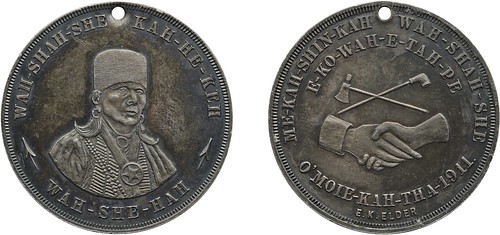
United States, Chief Wah-She-Hah (Bacon Rind), Osage Medal, 1911
Silver. Struck by Edward Knox Elder. WAH-SHAH-SHE KAH-HE-KEH – WAH-SHE-HAH, three-quarter facing bust of Chief Wah-She-Ha, rev., ME-KAH-SHIN-KAH WAH-SHA-SHE | E-KO-WAH-E-TAH-PE – O’MOIE-KAH-THA-1911 | E.K.ELDER, clasped hands below crossed tomahawk and peace pipe, 38.1 mm, pierced, but a blue-toned proof
PROVENANCE
F.C.C. Boyd Collection; John J. Ford, Jr. Collection, part XVI, Stack’s, October 17, 2006, lot 188
To read the complete lot description, see:
United States, Chief Wah-She-Hah (Bacon Rind), Osage Medal, 1911 Estimate 1,500 — 2,500 USD
(http://www.sothebys.com/en/auctions/ecatalogue/2018/historic-coins-and-medals-n09975/lot.199.html)
1917 Wilson's Successes Goetz Medal
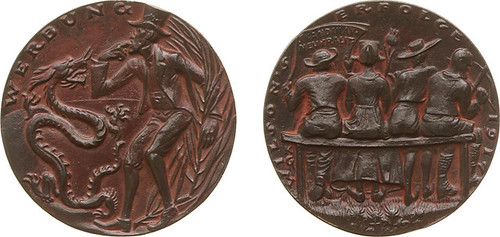
1917 - Medal 'Wilson's Successes / Wilsons Werbung bei den Neutralen' by Karl Goetz (Kienast194) - VZ President Wilson and Chinese dragon / KZ Seated Scandinavia, Netherlands, Spain en Switserland turn their back - iron cast 57 mm, brown patine, in box -
To read the complete lot description, see:
Lot 6770 1917 - Medal 'Wilson's Successes / Wilsons Werbung bei den Neutralen' by Karl Goetz (Kienast194)
(https://mpoauctions.com/en/browse?aid=32&cid=20465&lid=129578)
Civilian Conservation Corps. Token

Description: Round brass 24mm. CIVILIAN CONSERVATION CORPS. // GF / 10C IT / CO. 894 CCC / BONHAM, TEXAS. Please note surface condition issue. HWAC# 62312 Date: Location: Bonham, Texas
To read the complete lot description, see:
https://www.invaluable.com/auction-lot/-1-c-C804838851 (https://www.invaluable.com/auction-lot/-1-c-C804838851)
1941 Guernsey Two Shilling Sixpence Notes
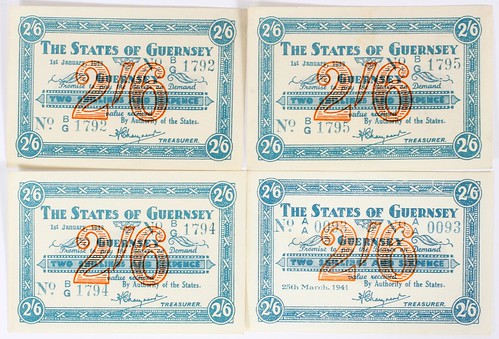
GUERNSEY TWO SHILLING & SIXPENCE BANKNOTE, 1941/1943, FOUR
FOUR "THE STATES OF GUERNSEY" TWO SHILLING AND SIXPENCE BANKNOTES. THREE WERE PRINTED JANUARY 1ST, 1943, THE FOURTH WAS PRINTED MARCH 25TH, 1941. ALL ARE PRINTED WITH THE SEAL OF BAILWICK ON THE REVERSE. NUMBERS INCLUDE: BG1794, BG1795, BG1792, AND AA0093. PRINTING OF BANKNOTES LESS THAN 5 POUNDS CEASED AFTER 1945. H 2 3/8'', L 3 5/8''.
To read the complete lot description, see:
GUERNSEY TWO SHILLING SIXPENCE BANKNOTE 1941 1943 FOUR
(https://dumoart.com/LotDetailSEO/2018051130_GUERNSEY-TWO-SHILLING-SIXPENCE-BANKNOTE-1941-1943-FOUR)
Swiss Shooting Festival Medal
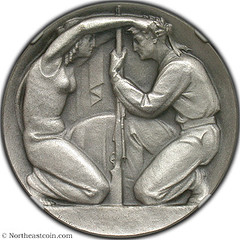
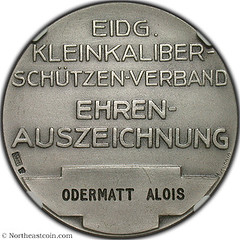
Switzerland Shooting Fest R-1967a
Silver. 35mm.
To read the complete lot description, see:
Switzerland Shooting Fest R-1967a (https://www.northeastcoin.com/viewImageStandalone.jsp?itemKey=zi35_465908905)
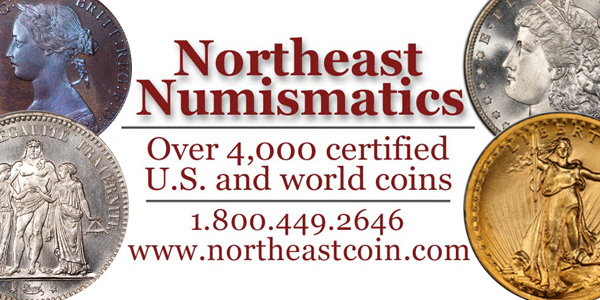
CNG AUCTION 108 CLOSES MAY 16, 2018
An Internet and Mail Bid Sale?
Closing Electronically on Wednesday, 16 May 2018, from 10 AM ET
Classical Numismatic Group is proud to present CNG 108, an Internet and Mail Bid Sale closing electronically on Wednesday, 16 May 2018, from 10 AM ET (U.S.). This sale offers 1243 lots with a presale estimate of $2.34 million.
Our annual spring sale features Greek, Celtic, Oriental Greek, Central Asian, Roman Provincial, Roman Republican, and Roman Imperial coinage. Additionally, there are featured selections of Romano-Byzantine weights, Byzantine, Early Medieval, Islamic, World, Siege, and British coinage, as well as a small selection of antiquities.
CNG 108 is highlighted by a number of collections and individual rarities, which make up the majority of coins on offer:
• Ancient and World Coinage from the D. C. Kopen Collection
• Greek Coins from the José Miguel Márquez del Prado Collection
• Coins of Thrace and Macedon from the Belgica Collection (Part II)
• Alexander Type Coins from the Colin E. Pitchfork Collection
• Impressive Zeus Ammon Facing Bust Electrum Stater of Kyzikos
• Third Known Seal and Octopus Electrum Stater of Phokaia
• The MNL Collection of Seleukid Coins (Part I)
• Baktrian and Indian Coins from the David Nelson Collection
• Roman Coins from the Fendi Collection
• Roman Republican and Imperatorial Coins from the Jonathan P. Rosen Collection
• Licinius I Facing Bust Aureus – Among the Finest Known
• Late Roman and Byzantine Coins from the D. Massey Collection
• Bulgarian Coins and Seals from the Iconodule Collection
• Multiple Talers and Dutch Coinage from the Jonathan K. Kern Collection
• The Jonathan K. Kern Collection of Siege Coinage
• Superb Edward ‘the Black Prince’ AV Hardi d’Or
• Selections from the Anthony Halse Collection of British Pattern Coinage
Catalogs for CNG 108 have been mailed to our active mailing list and bidding is open on the site. Some of the individual highlights from CNG 108 are:
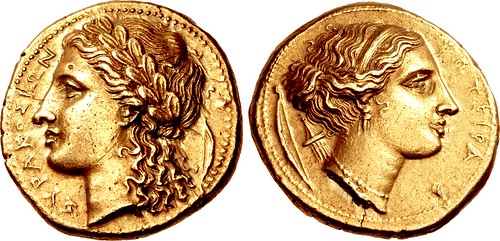
Lot 19 – SICILY, Syracuse. Agathokles. 317-289 BC. EL 100 Litrai – Stater (18.5mm, 6.98 g, 9h). Struck circa 310-306/5 BC. Head of Apollo left, with long hair, wearing laurel wreath; SYPAKOSION to left, bow to right / Head of Artemis right, wearing taenia, triple-pendant earring, and pearl necklace; quiver over shoulder, bow to left, SOTEIPA to right. Jenkins Group D, dies a/a; BAR Issue 13; HGC 2, 1293; SNG Lloyd 1433; BMC 252 = GPCG pl. 26, 33; Jameson 844 (all from the same dies). EF, hairline flan crack. Fine style. Better centered and as well struck as the Prospero specimen that recently resold in New York Sale XXXII (lot 100) for hammer $50,000. Estimated at $30,000
Ex Palombo 12 (6 December 2013), lot 11.
Impressive Portrait of Zeus Ammon
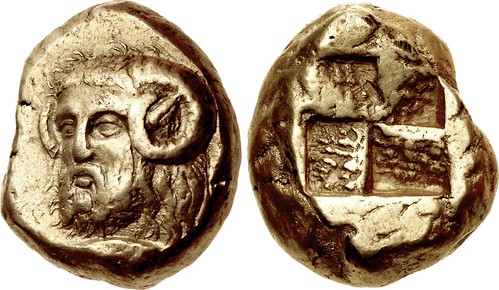
Lot 171 – MYSIA, Kyzikos. Circa 450-330 BC. EL Stater (17mm, 15.99 g). Horned and bearded head of Zeus Ammon facing slightly left / Quadripartite incuse square. Von Fritze I 183; Greenwell –; Boston MFA 1559 = Warren 1425 = Traité II 2624, pl. 173, 32; SNG BN –; SNG von Aulock –; BMC –; FSD –; Gillet –; Gulbenkian –; Jameson –; Myrmekion 100 (same die and punch); Rosen –; Weber –; Sotheby, 8 July 1996, lot 60 = Leu 59, lot 125. Good VF. Exceptional for this extremely rare issue, apparently the fourth known. Estimated at $20,000
Ex Houghton and Kern Collections
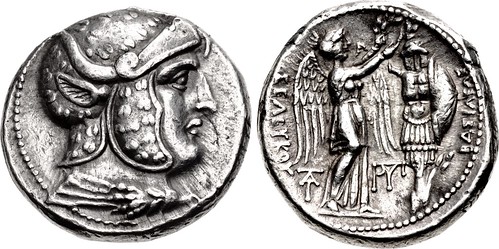
Lot 282 – SELEUKID EMPIRE. Seleukos I Nikator. 312-281 BC. AR Tetradrachm (26mm, 17.05 g, 10h). Susa mint. Struck circa 305/4-295 BC. Head of hero (Alexander or Seleukos?) right, wearing helmet covered with panther skin and adorned with the ear and horns of a bull / BASI?EOS SE?EYKOY, Nike standing right, placing wreath on trophy; monogram to lower left, monogram in lower middle field. SC 173.4; ESMS Tr.7 (A4/P1 – this coin referenced and illustrated); ESM 426; HGC 9, 20; CSE 1023 (this coin); SNG Spaer –. EF, toned. Estimated at $15,000
From the MNL Collection. Ex Jonathan K. Kern Collection; Numismatic Fine Arts XXVI (14 August 1991), lot 96; Numismatic Fine Arts XVIII (31 March 1987), lot 276; Arthur Houghton Collection, 1023.
There is much debate concerning the identity of the hero on the obverse of this type. The most common suggestions are Alexander the Great, Seleukos I, or a personification of Dionysos. See O.D. Hoover, “The Identity of the Helmeted Head on the ‘Victory’ Coinage of Susa,” SNR 81 (2002), for the most recent treatment of this debate.
Ex August Voirol Collection
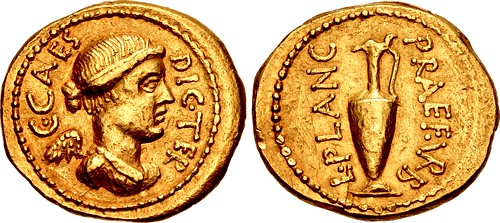
Lot 535 – The Caesarians. Julius Caesar. Late 46-early 45 BC. AV Aureus (21mm, 7.98 g, 6h). Rome mint; L. Munatius Plancus, praefectus Urbi. Diademed and draped bust of Victory right; C • CAESAR DIC • TER around / Sacrificial jug with one handle; L • PLANC upward to left, PRAEF • (VR)B downward to right. Crawford 475/1a; CRI 60; Calicó 45; Sydenham 1019-1019a; BMCRR Rome 4118; RBW 1663; Biaggi 29. Good VF, a few marks. Estimated at $7500
From the Jonathan P. Rosen Collection. Ex Chris J. Krausz Collection (Malter 51, 2 June 1993), lot 137; August Voirol Collection (Münzen und Medaillen AG 38, 7 December 1968), lot 262; M. Ratto (19 January 1956), lot 6.
The aurei of L. Munatius Plancus were distributed during Caesar’s triumph of October 45 BC, celebrating his final defeat of the Pompeians at Munda the previous year. This triumph raised some concerns in Rome, as it marked a victory over fellow Romans, an event never before deserving a triumph. Such actions only heightened the fears in some quarters over Caesar’s intentions, fears that lead to his assassination six months later.
Before his murder, Caesar appointed Plancus governor of Transalpine Gaul, where he founded the colony of Lugdunum.
Licinius I Facing Aureus
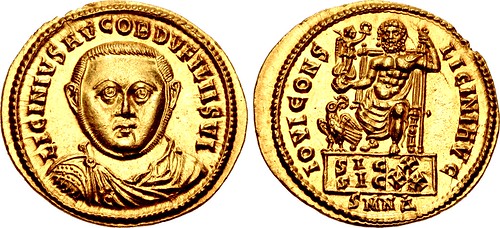
Lot 678 – Licinius I. AD 308-324. AV Aureus (21.5mm, 5.33 g, 11h). Decennalia issue. Nicomedia mint, 4th officina. Struck AD 321-322. LICINIVS AVG OB D V FILII SVI, bareheaded, draped, and cuirassed facing bust / IOVI CONS LICINI AVG, Jupiter, holding Victory on globe in right hand and scepter in left, seated facing on high-backed throne set on platform inscribed SIC •X•/SIC •XX• in two lines; at feet to left, eagle standing left, head right, holding wreath in beak; SMN?. RIC VII 41; Depeyrot 31/1; Calicó 5094; Hunter –. Superb EF, fully lustrous. Exquisitely detailed and artistically important facing portrait struck in high relief, paired with an equally skilled and evocative Jupiter. Among the finest known. Estimated at $75,000
Ex Tkalec (24 October 2003), lot 412.
Earlier facing head portraits can be found on aurei of Postumus, Carausius, Maxentius, and Constantine I, but the great rarity of these issues today suggests they were only struck in very limited quantities for special occasions or were experiments that failed to gain traction. The facing head aurei of Licinius I and II, struck for their tenth and fifth anniversaries, respectively, thus mark the first effort to put facing-head aurei into general circulation in somewhat sizeable numbers and set a precedent for what will eventually become the norm for later Roman and Byzantine issues.
It is often remarked that while earlier portraits of emperors attempt to capture individuality (not necessarily reality), late Roman portraits subsume individuality in favor of a quasi-divine image. While the Licinian issues are not devoid of individualized features (see for example, NAC 62, lot 2093, which shares the same reverse die as our coin but carries a more mature portrait of Licinius II wearing long sideburns), through their rigid frontality and intense gaze they transfix the viewer in a startlingly bold and immediate way. They are, like the religious icons of their time, both didactic and devotional.
AR 4 Taler of Christian Ludwig
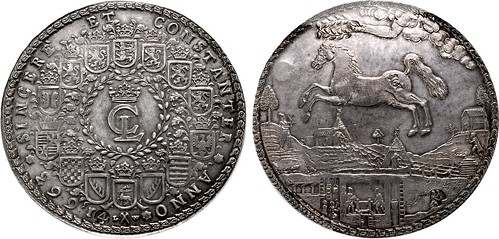
Lot 924 – GERMANY, Braunschweig-Lüneburg-Celle (Herzogtum). Christian Ludwig. 1648-1665. AR 4 Taler (71mm, 8h). Clausthal mint; mm: crossed hooks; Lippold Weber, mint master. Dated 1663 LW. Crowned CL monogram within laurel wreath surrounded by 14 crowned coats of arms set on oak wreath; 4 stamped below / Horse leaping left, monogram on flank; above, arm holding laurel wreath reaching from the clouds; in background, scene of Clausthal countryside; below, mining scene. Welter –; Davenport 176; KM 223.4. In NGC encapsulation, 4212835-001, graded MS 63. Toned. Estimated at $5,000
From the Jonathan K. Kern Collection.
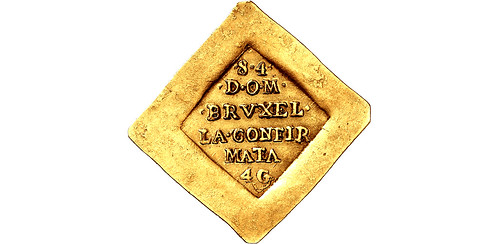
Lot 1043 – DUTCH REVOLT (Nederlandse Opstand), Low Countries. Brussel. Blockaded by the Spanish, 1584-1585. AV 4 Gulden Klippe (23x23mm, 3.39 g). Dated [15]84. · 8 · 4 ·/· D · O · M ·/· BRVXEL ·/LA · CONFIR/ATA/4 G in six lines within quadrate / Incuse of obverse. Vanhoudt I 275; Gelder, Noodmunten, 185; Delmonte, Or 132; Maillet 7; Lasser –. In NGC encapsulation, 4212881-001, graded MS 61. Estimated at $15,000
Ex Archer M. Huntington Collection, ANS 1001.1.1246 (Numismatica Genevensis SA VII, 27 November 2012), lot 593 (hammer 20,000 CHF on an estimate of 4000 CHF).
Reportedly, a total of 661 examples of this denomination were struck.
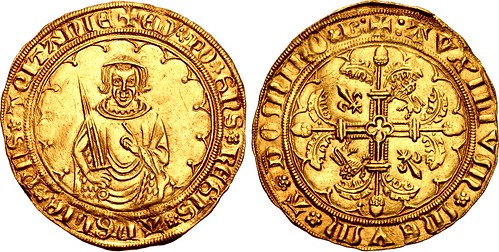
Lot 1143–PLANTAGENET (ANGLO-GALLIC). Edward the Black Prince. As Prince of Aquitaine, 1362-1372. AV Hardi d’Or (26.5mm, 3.95 g, 6h). Bordeaux mint. Struck circa 1368–1371/2. + ?D’ · PO · GnS · R?GIS · ?nGLI? · PnS · ?QIT?NI? (rosette stops), half-length figure of Edward facing, wearing plain diadem, holding sword in left hand and pointing at it with his right, within tressure of arches / + : ?VXILIVm · m?Vm · ? · DOmInO · B : (rosette stops within), cross quernée, with quatrefoil at center; leopards and lis alternating in angles; all within tressure of arches. AGC 178, 3/a; Elias 161; Elias Collection 250 var. (obv. legend); Schneider 60 var. (same); Duplessy, Féodales 1122; Poey d'Avant 2940; SCBC 8128. Superb EF, unobtrusive mark in obverse legend. Well struck and with remarkably detailed portrait. Estimated at $15,000
Humphrey Sutherland praised the restraint and foresight of the unknown master who designed this type, who “in [an] age when sumptuous decoration of all redundant space was the normal fashion, was content–and dared–to leave the field totally devoid of ornament within its encircling tressure. By this means, he concentrated upon this larger and more personal portrait, so lifelike in its almost voluptuous forms, an emphasis which the Italian artists themselves were only just beginning to estimate and enjoy.” Art In Coinage, p. 154.
Printed catalogs for CNG 108 are now available. To order the catalog, please call our U.S. office at (717) 390-9194. Catalogs have been mailed to customers on CNG’s active mailing list. Prospective bidders may also view the virtual catalogs at CNG 108 Virtual Catalog. The sale can be viewed online at cngcoins.com, sixbid.com, and numisbids.com.
In addition to Internet & Mail Bid Sale 108, CNG will also feature over 1000 lots from many of the same collections listed above in their Electronic Auction 421, closing two weeks later on Wednesday, 30 May 2018, from 10AM ET (U.S.). Bidding for CNG Electronic Auction 421 will begin on 9 May 2018.
CNG is currently accepting consignments for future auctions sales. Please contact the firm for further details and consignment deadlines.
For further details and any additional information, please contact CNG, Inc. at:
Classical Numismatic Group, Inc.
P.O. Box 479
Lancaster, PA 17608-0479
Telephone: (717) 390-9194
Fax: (717) 390-9978
Email: cng@cngcoins.com
'HARALD BLUETOOTH' MEDIEVAL TREASURE FOUND
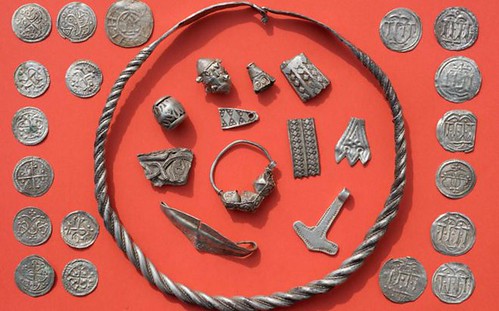
Treasure linked to the reign of 10th Century Danish King Harald Bluetooth has been dug up in northern Germany.
An amateur archaeologist and a 13-year-old boy found a silver coin on the Baltic island of Rügen in January when scanning a field with metal detectors.
They found braided necklaces, a Thor's hammer, brooches, rings and about 600 coins, probably buried in the 980s.
"This trove is the biggest single discovery of Bluetooth coins in the southern Baltic sea region and is therefore of great significance," said lead archaeologist Michael Schirren.

Harald Bluetooth was born a Viking and is credited with unifying Denmark and introducing Christianity there during his reign.
The king was immortalised by Nordic technology firms when they embedded their wireless "Bluetooth" technology in digital gadgets.
To read the complete article, see:
Germans find 'Harald Bluetooth' medieval treasure (http://www.bbc.com/news/world-europe-43786129)

TRINIDAD AND TOBAGO DISCONTINUES CENT
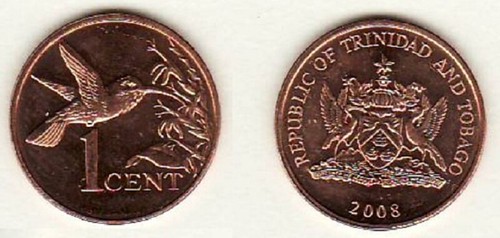
From July 3, 2018, the one-cent coin will no longer be accepted as legal tender in Trinidad and Tobago.
The Central Bank of Trinidad and Tobago said in a statement on April 1, 2018, that although the coins will no longer be accepted by local banks and merchants, the public can redeem one-cent coins at their commercial banks or the Central Bank up to July 2, 2018.
From July 3, 2018, one cent coins can still be redeemed for value 'indefinitely' at counters of the Central Bank.
The Central Bank said the change will only affect cash transactions; all non-cash transactions such as cheque and electronic payments will continue as usual as there would be no need to round these payments.
To read the complete article, see:
Central Bank: One cent coin no longer legal tender from July 3
(http://www.looptt.com/content/central-bank-one-cent-coin-no-longer-legal-tender-july-3)
2019 JODY CLARK QUEEN ELIZABETH II EFFIGY
 The Queen is getting a makeover on Australia's coins.
The Queen is getting a makeover on Australia's coins.
The federal government says a new effigy of Queen Elizabeth II, designed by the UK Royal Mint's engraver Jody Clark, will be rolled out and is expected to be seen on 2019-dated coins.
"This new effigy will replace the Ian Rank-Broadley effigy which has been in use since 1998," Assistant Treasurer Michael Sukkar said on Sunday.
To read the complete articles, see:
Australian coins to get an updated Queen
(http://www.news.com.au/national/breaking-news/australian-coins-to-get-an-updated-queen/news-story/0cc0636bbc59f5c447ca4365005b1181)
New effigy of
Britain's Queen Elizabeth II soon to be circulated on Australian coins photo preview
(http://www.epa.eu/economy-business-and-finance-photos/people-financial-business-services-photos/new-effigy-of-britain-s-queen-elizabeth-ii-soon-to-be-circulated-on-australian-coins-photos-54280878)

GERMANS LINE UP TO BUY SPECIAL EURO COIN

In several cities nationwide where a German Central Bank (Bundesbank) is located, such as Berlin, Nuremberg and Essen, eager coin collectors patiently waited in line.
On Thursday morning, hundreds of young and old coin enthusiasts waited outside the Central Bank branch in the Berlin district of Charlottenburg, reported broadcaster RTL.
The special coins - of which 3.4 million have been produced in Germany - are available at the 35 Bundesbank branches across the country from Thursday onward.
Highly sought after for their innovative design, an orange, translucent polymer ring encircles the centre of the coin, separating it from its outer ring. The unique material makes the coin much more difficult to counterfeit, with the plastic ring easy to recognize with the naked eye and difficult to reproduce.
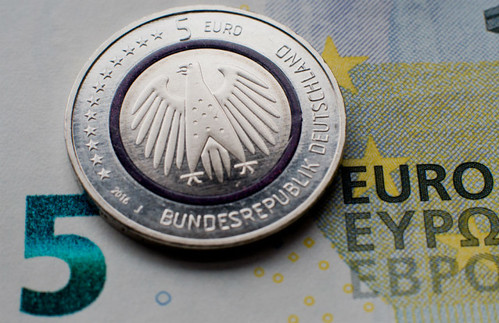
It is the second in a five-part series of special edition coins called “Climate Zones of the Earth.”
The series began in 2017 and one coin is to be issued each year until 2021. The 2018 edition is called “Subtropical Zone” while last year’s edition was called “Tropical Zone" and had a red polymer ring.
To read the complete article, see:
Hundreds queue across Germany for new special edition five-euro coin
(https://www.thelocal.de/20180419/hundreds-queue-across-germany-for-new-special-edition-five-euro-coin)
To read the earlier E-Sylum articles, see:
THE STATE MINTS OF BADEN-WUERTTEMBERG (http://www.coinbooks.org/v20/esylum_v20n49a32.html)
POLYMER RING COIN WINS IACA AWARD (http://www.coinbooks.org/v20/esylum_v20n51a17.html)
BOER WAR HERO'S ALBERT MEDAL UP FOR SALE
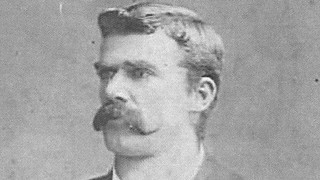 It took ten years but Winston Churchill kept his promise to the train driver who helped him save dozens of British troops during the Boer War.
It took ten years but Winston Churchill kept his promise to the train driver who helped him save dozens of British troops during the Boer War.
The future prime minister was a 25-year-old war correspondent in South Africa when the armoured train he was travelling on was derailed near Durban by enemy mortar shells in December 1899.
Undeterred by Boer sharpshooters Churchill ran to the locomotive and found the driver, Charles Wagner, and the badly injured fireman, Alexander Stewart, by the side of the track. For nearly an hour they kept the engine running, shunting the three wrecked carriages out of the way so the train could make its escape.
A decade later Churchill had risen to become home secretary but he never forgot his pledge to the stricken men that a “wounded man who continued to do his duty was always rewarded for distinguished gallantry”, and arranged for them both to get the Albert Medal for Lifesaving.
The medal awarded to Wagner is expected to sell for more than £20,000 at an auction in London next month.
David adds:
This British Boer War medal has quite a history. The direct connection to Winston Churchill certainly should add to the appeal and I’m sure it will bring a worthy price. Personally I really like medals and especially those with stories.
To read the complete article, see:
Medal given to Churchill’s Boer War hero up for sale
(https://www.thetimes.co.uk/article/medal-given-to-churchill-s-boer-war-hero-up-for-sale-29m8qg7nv)
THE BOOK BAZARRE
KARL MARX €0 BILLS ARE RED HOT
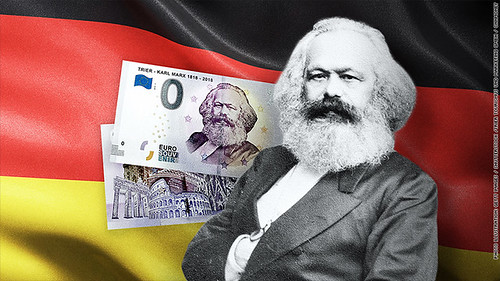
The German city of Trier is selling thousands of souvenir bank notes with a face value of zero euros in honor of Karl Marx, revolutionary, political philosopher and author of "The Communist Manifesto."
The city's tourism department is selling the bills for €3 each to mark Marx's 200th birthday on May 5.
Marx was born in Trier in 1818 and went to high school in the city before leaving to study at university.
The first run of 5,000 bills sold out after going on sale on Monday. The city is now printing 20,000 more to meet demand from buyers around the world, including Australia, Brazil and the United States.
To read the complete article, see:
Karl Marx €0 bills are red hot
(http://money.cnn.com/2018/04/19/news/zero-0-euro-bills-bank-notes-germany-karl-marx/index.html)
To read earlier E-Sylum articles, see:
THE ZERO RUPEE ANTI-CORRUPTION NOTE (http://www.coinbooks.org/esylum_v19n21a36.html)
THE ZERO EURO BANKNOTE (http://www.coinbooks.org/esylum_v19n32a28.html)
COUNTERFEIT AUSTRALIA $50 BANKNOTES
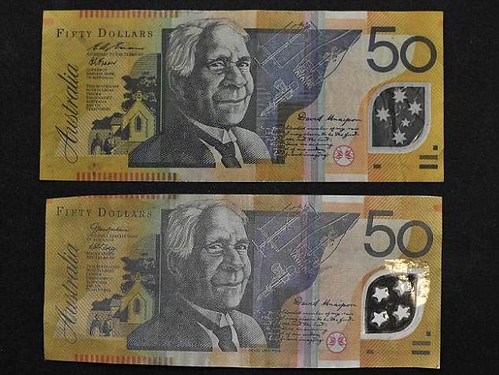
Can you spot the fake? One of these $50 notes is real, and one of them is not. The genuine bill is at the top, and the fake at the bottom. The fake $50 is more pale, its edges are skewed, has only four stars and the embossing on the window is missing (photo obtained by The Daily Telegraph)
A Sydney man has been caught making $1 million in counterfeit $50 notes, despite Australia boasting it has one of the lowest rates of counterfeiting in the world.
Benjamin Gillette-Rothschild, 34, pleaded guilty in the Downing Centre District Court, The Daily Telegraph reports.
How he made the fake notes remains a secret due to the court order, but he boasted the process was so easy he did it all from the comfort of a leather chair.
Gillette-Rothschild allegedly used 'fake names' to buy three commercial printers for $80,000, ink, and specialised plastic.
To read the complete article, see:
Can you spot the fake? Sydney man who made $1million in counterfeit $50 notes boasts he forced complete
overhaul of Australia's currency design (http://www.dailymail.co.uk/news/article-5641957/Can-spot-fake-Sydney-man-1-million-counterfeit-50-notes.html)

INDIANS HOARD CASH AS BANKS RUN OUT
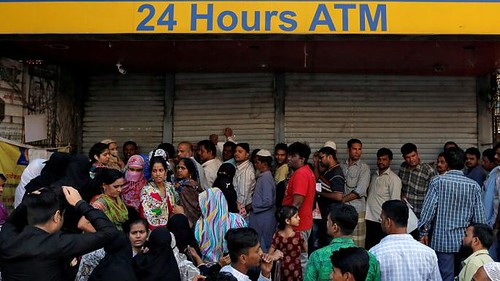
India is facing a cash crisis, with ATMs running dry and banks reporting a £7 billion shortfall in currency, threatening a return to the chaos of Narendra Modi’s “demonetisation” initiative.
Banks and cash machines are being closed as supplies of banknotes run out. In the hardest hit areas families are pawning valuables to survive. The State Bank of India said that ATM withdrawals hit their highest levels for almost a decade over the past year as Indians quietly rebuilt cash savings.
India now has more than £200 billion of cash in circulation, back at the levels before demonetisation. The government has increased printing but the sight of long queues outside banks has revived uncomfortable memories of 2016, when Mr Modi scrapped India’s two largest banknotes overnight in a crackdown on tax evasion and corrupt “black money”.
At a stroke 86 per cent of all currency in India was rendered worthless until it could be exchanged for new notes. The move plunged the country into months of turmoil and hit economic growth.
To read the complete article, see:
Banks run out of money as Indians hoard cash
(https://www.thetimes.co.uk/article/banks-run-out-of-money-as-indians-hoard-cash-again-rlvlz6fn5)
BASIS: NEW CRYPTOCURRENCY FROM PRINCETON
The team behind Basis says it is designing a "stable cryptocurrency" that will maintain a fixed value and thus be better suited for making purchases. That's in contrast to bitcoin and other popular cryptocurrencies whose wild price swings make it undesirable as a day-to-day replacement for traditional money.
"The price volatility of cryptocurrencies is one of their biggest barriers to widespread adoption," Nader Al Naji, the CEO and cofounder of Basis, wrote in a Medium post on Wednesday announcing the funding.
Al Naji says cryptocurrencies are now used almost exclusively as a means of speculation instead of as a way to buy things, so Basis aims to make a digital token backed by "an algorithmic central bank" that will simulate inflation and deflation to control the price, "just like a real currency."
A company representative told Business Insider that Basis's target market was in the developing world, where even traditional currencies can experience stretches of volatility. Basis believes people could eventually use its tokens even for things like salaries, loans, or contracts.
Basis isn't the only cryptocurrency startup hoping to create a stable token that can be used to buy things — for example, the controversial cryptocurrency Tether intends to keep its price steady by basing its value on the US dollar.
To read the complete article, see:
3 Princeton grads just got $133 million from Silicon Valley's hottest investors for a cryptocurrency that could actually
replace money (http://www.businessinsider.com/basis-investment-gv-andreessen-horowitz-lightspeed-2018-4)
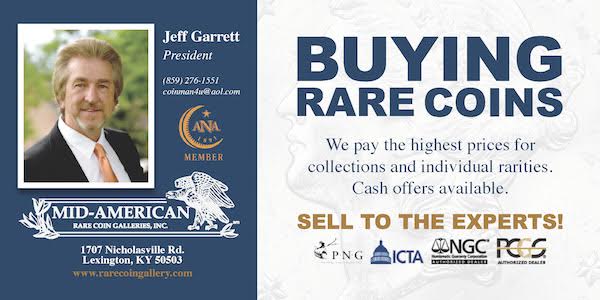
THE MAGNET AND BLENDER COUNTERFEIT TESTS
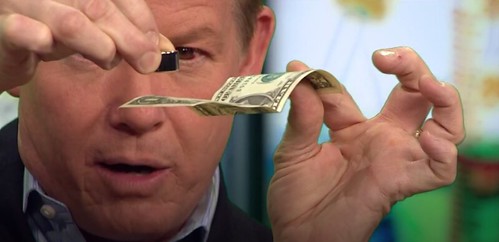
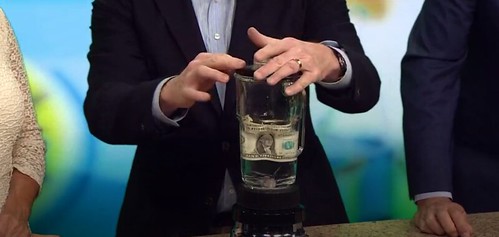
To watch the complete video, see:
Using the blender test to detect counterfeit money
(http://www.9news.com/video/news/local/science/steve-spangler-science/using-the-blender-test-to-detect-counterfeit-money/73-8098185)
IN OTHER NEWS: APRIL 22, 2018
Oldest gold in Britain
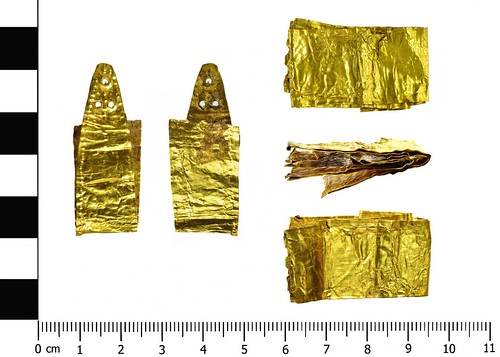
The ‘exceptionally rare’ gold strip is thought to be from the earliest Bronze Age around 2500 to 2000bc.
The piece of gold, a folded strip now in two pieces, was bought by John Workman at the car boot sale in Berinsfield, south Oxfordshire.
A treasure inquest at Oxford Coroners Court, on Tuesday, heard the gold was bought with as part of a box of gold watch parts in March 2016.
Mr Workman spotted the unusual piece and showed it to friends who had interest in metal detecting and was encouraged to get in touch with the British Museum.
To read the complete article, see:
'Oldest gold in Britain' bought at an Oxfordshire car boot sale
(http://www.oxfordmail.co.uk/news/16175039.__39_Oldest_gold_in_Britain
__39__bought_at_an_Oxfordshire_car_boot_sale/)
Indian Head Cent Found In Change
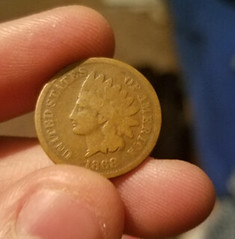
To read the complete article, see:
This penny I got in my change is 150 years old (https://www.reddit.com/r/mildlyinteresting/
comments/8di5lw/this_penny_i_got_in_my_change_is_150_years_old/)

FEATURED WEB SITE: NUMISMACLUB
This week's Featured Web Site is Numismaclub, the "Open Numismatic Society". The site hosts images of numismatic items in hundreds of categories including coins token. medals and paper money.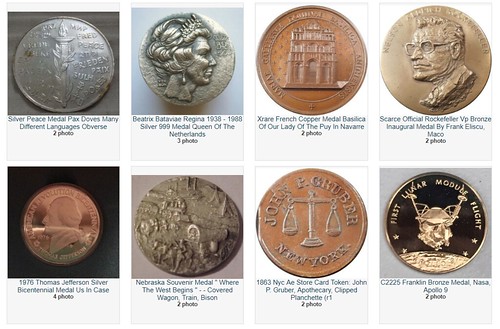
http://numismaclub.com/

